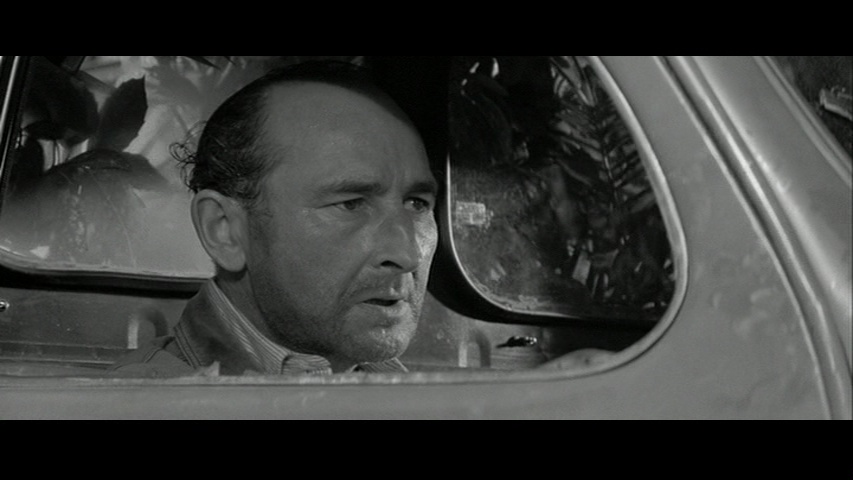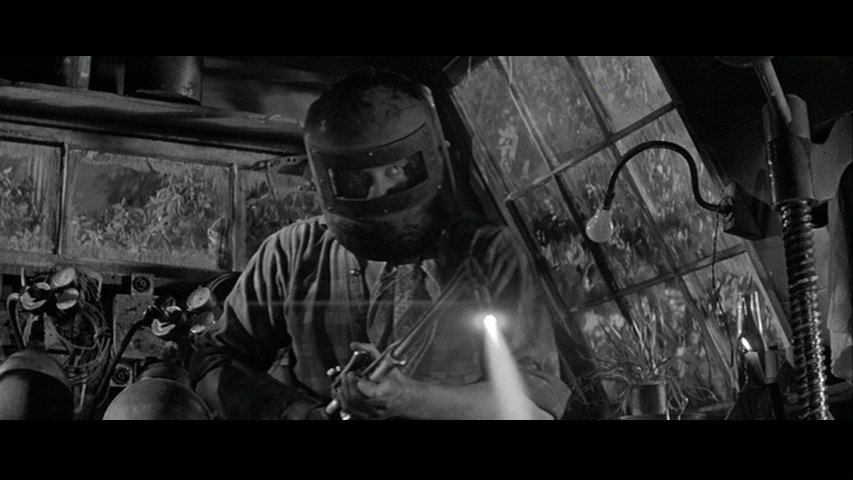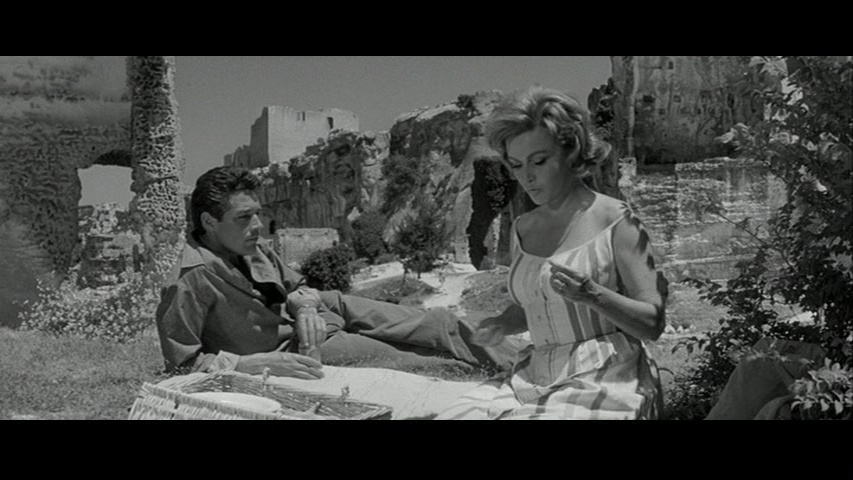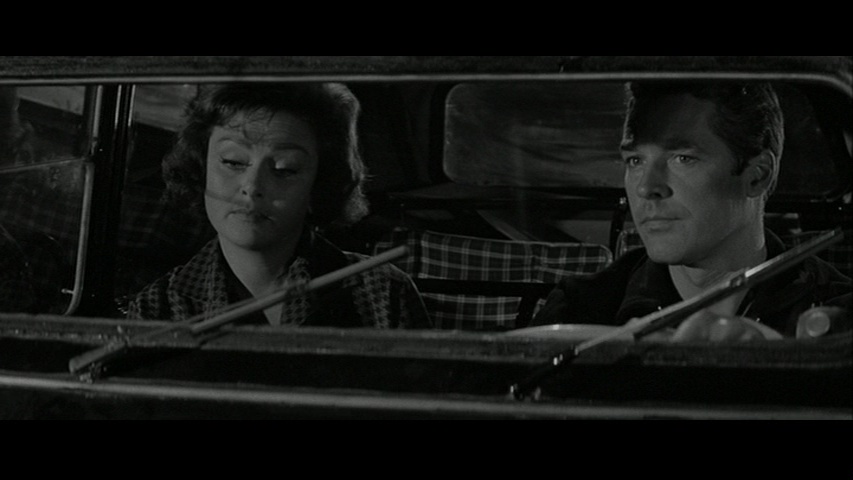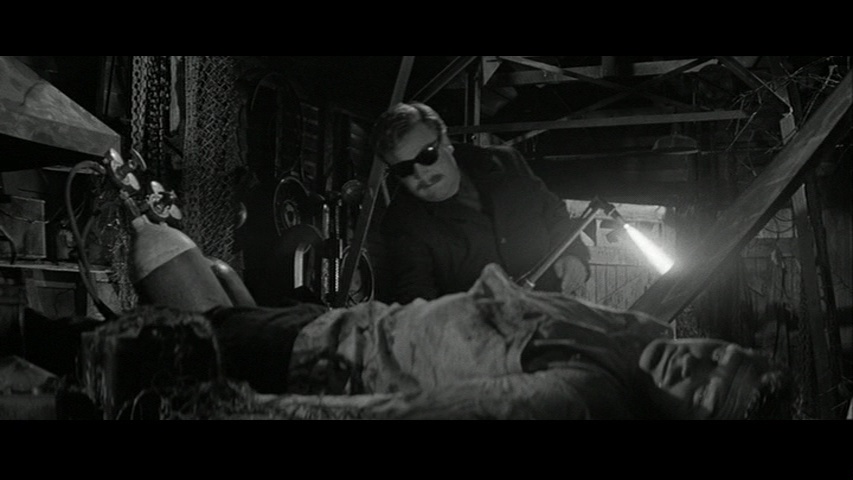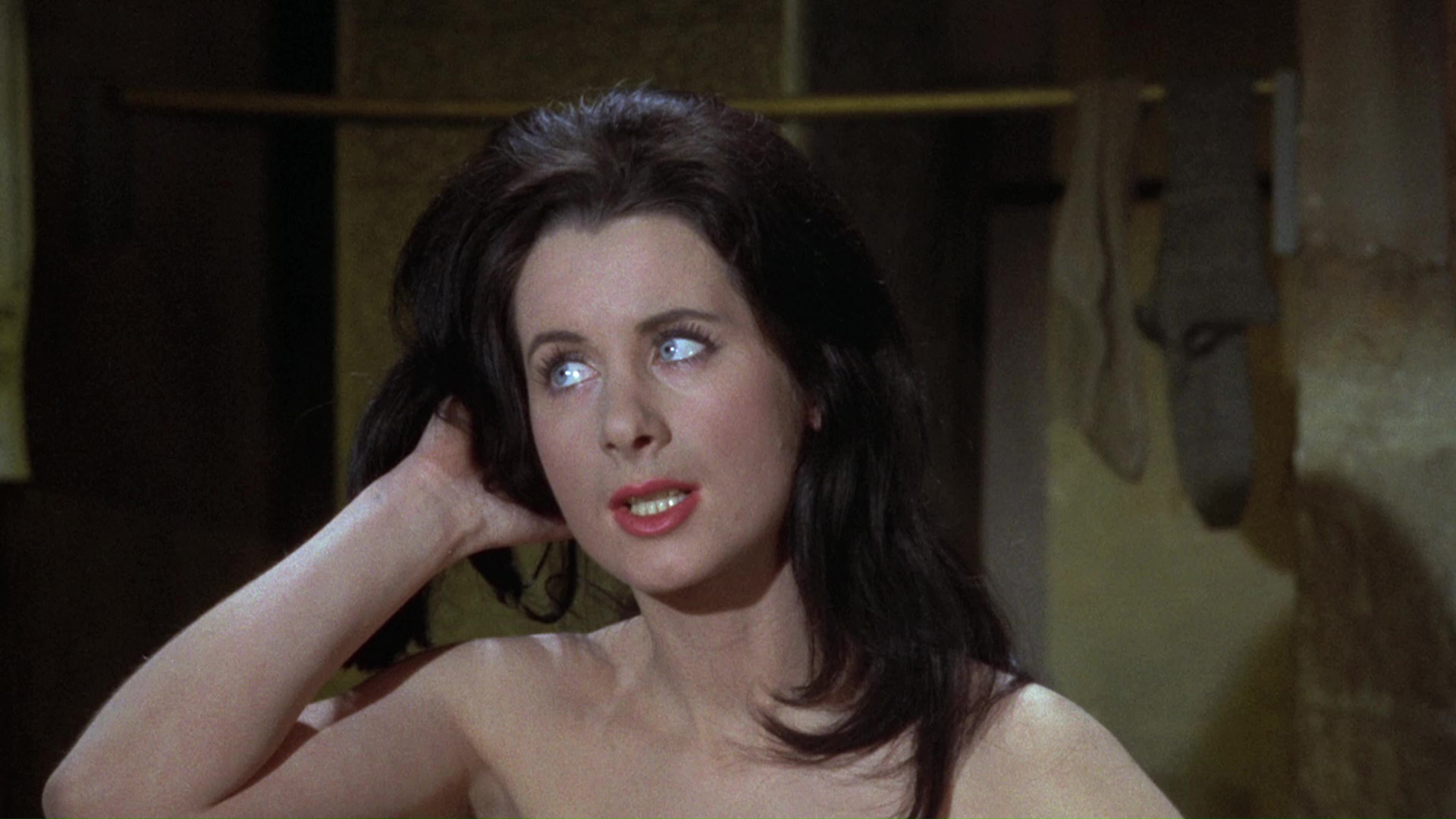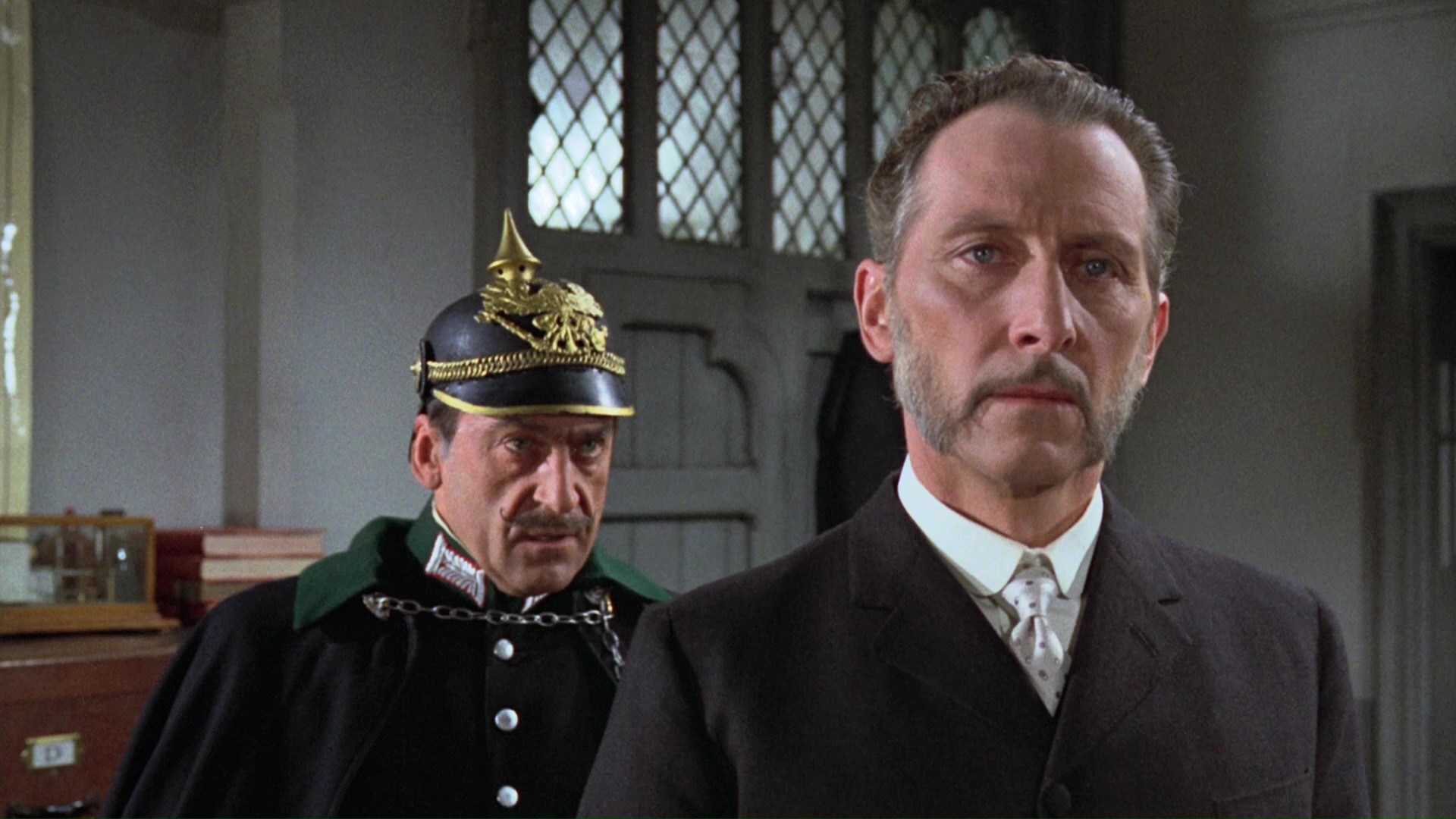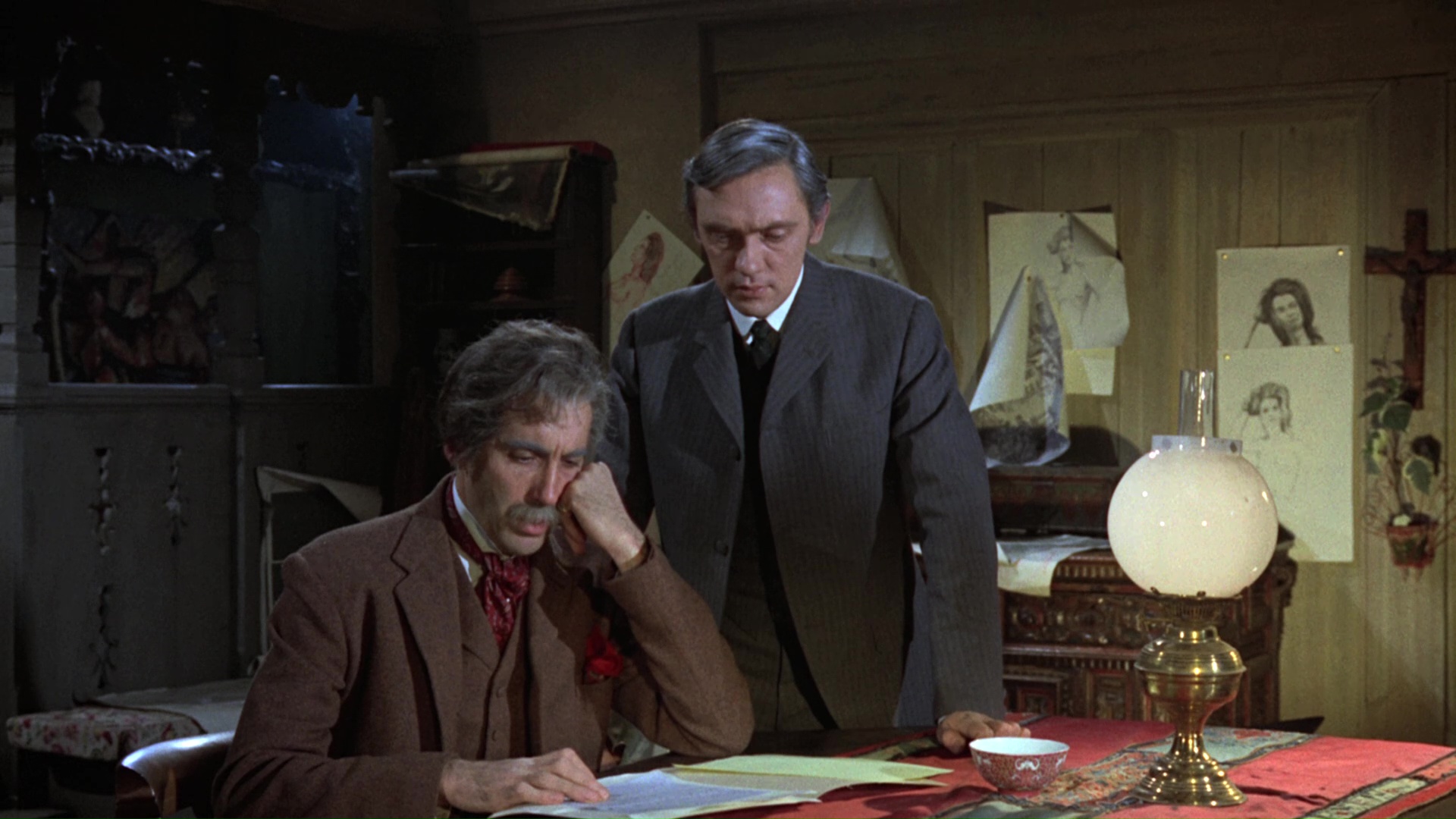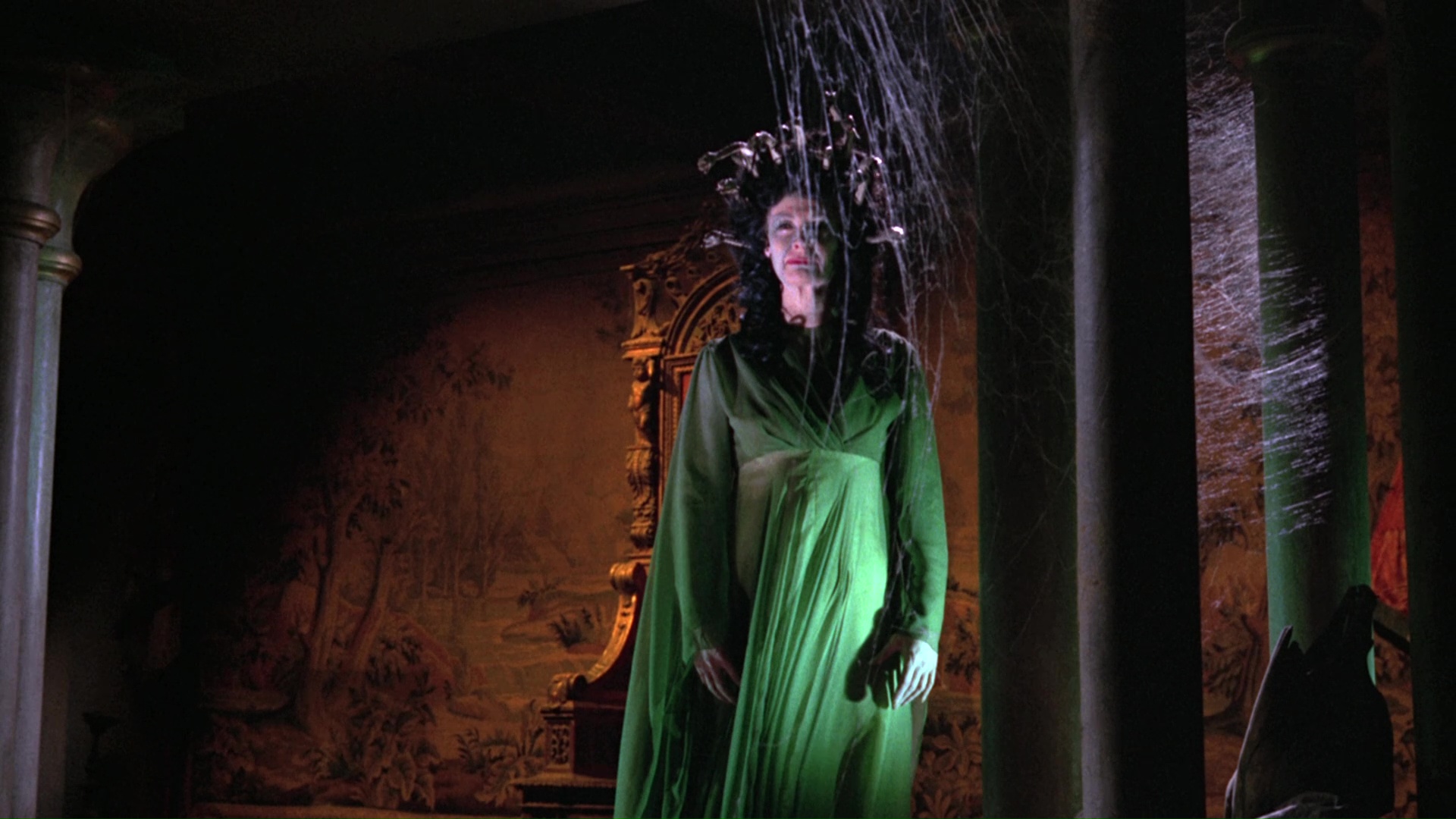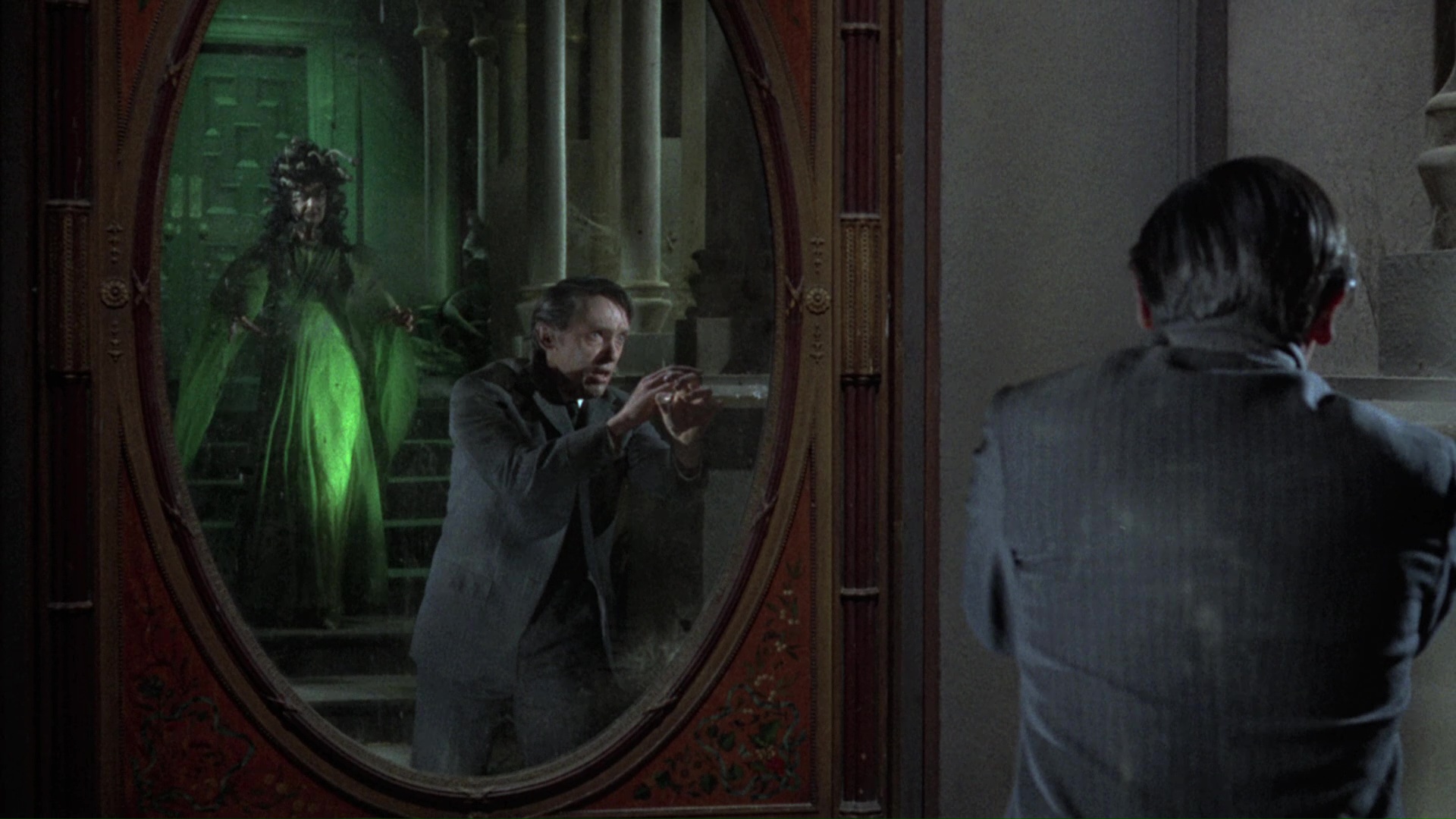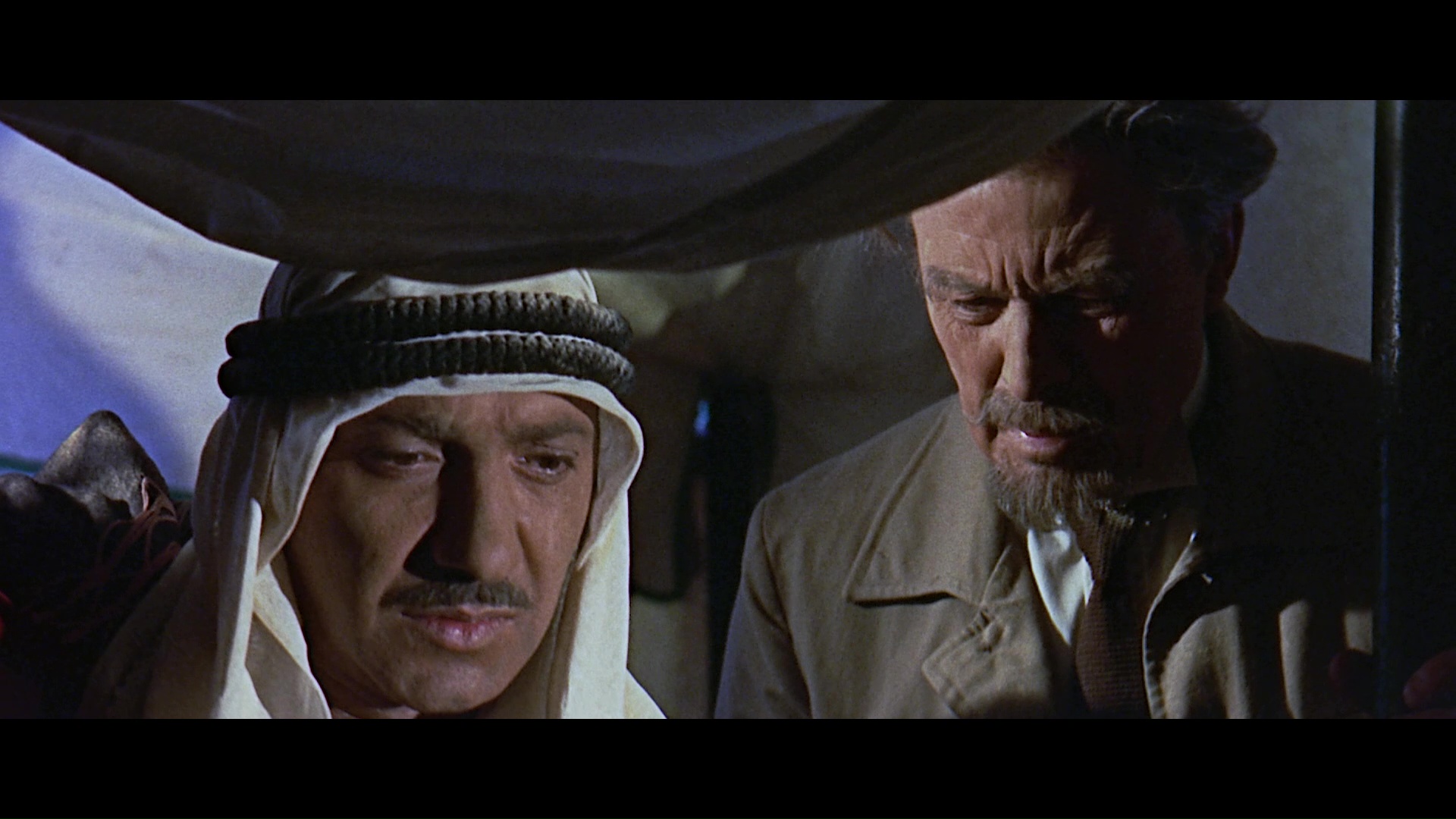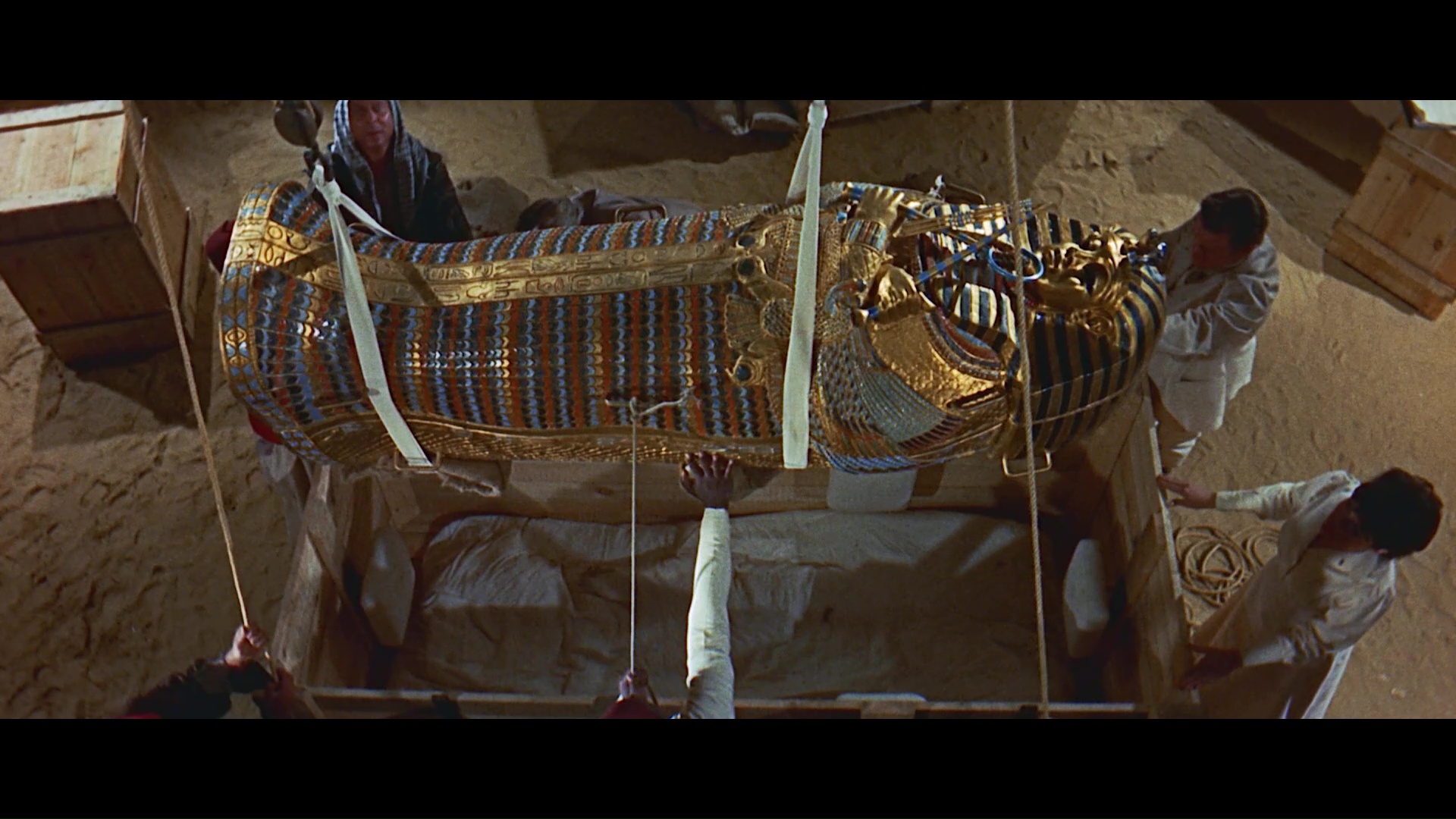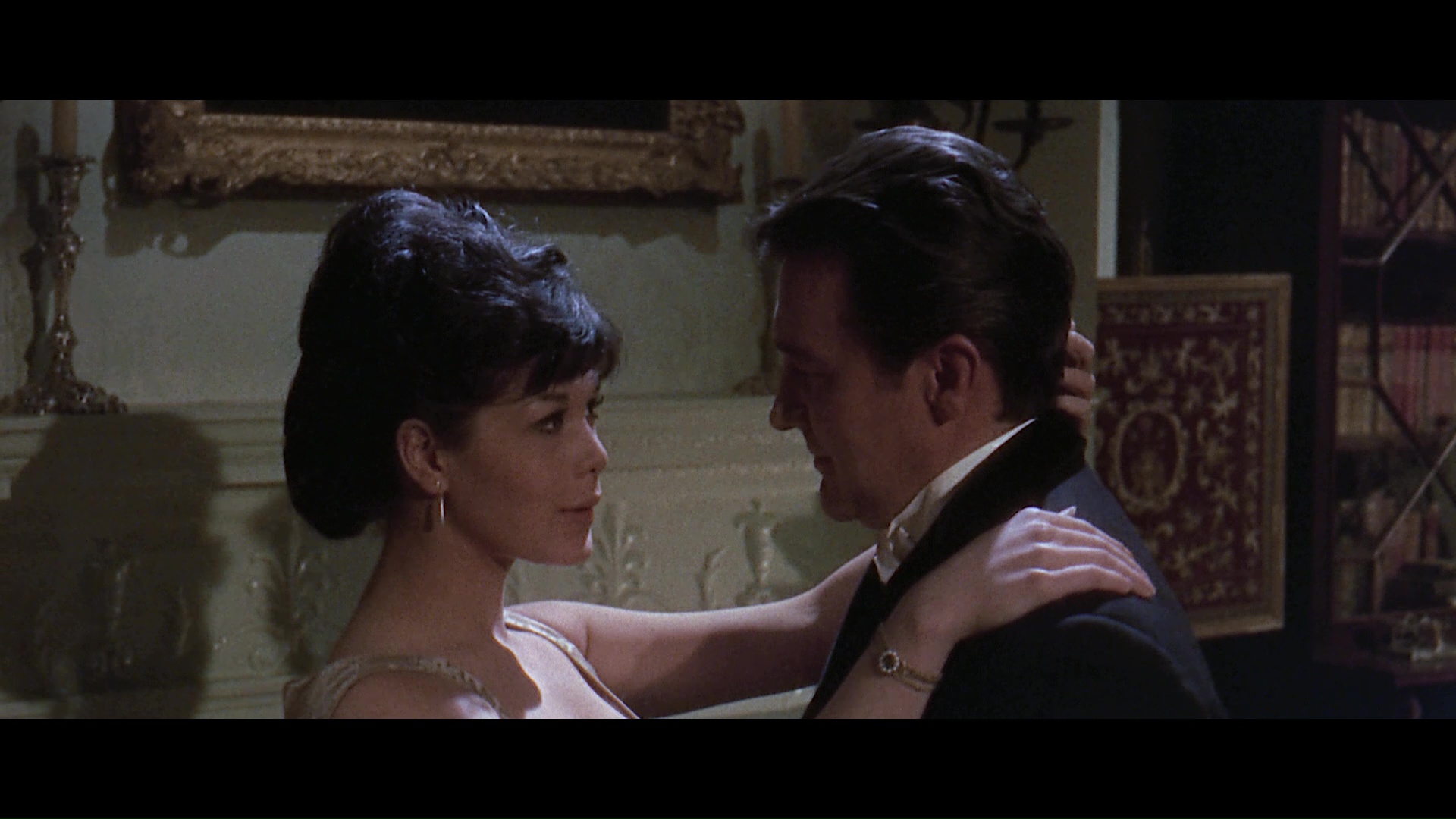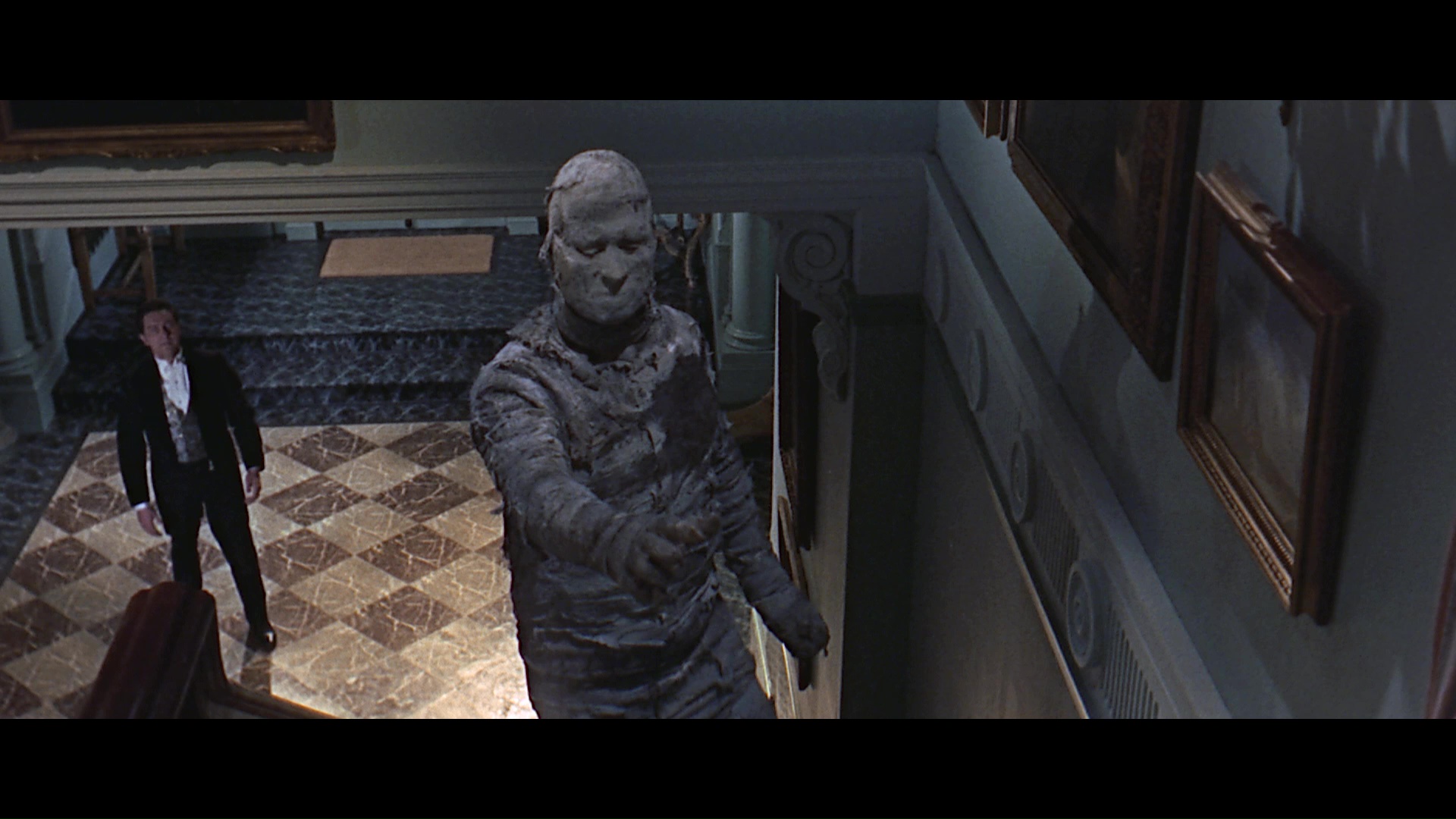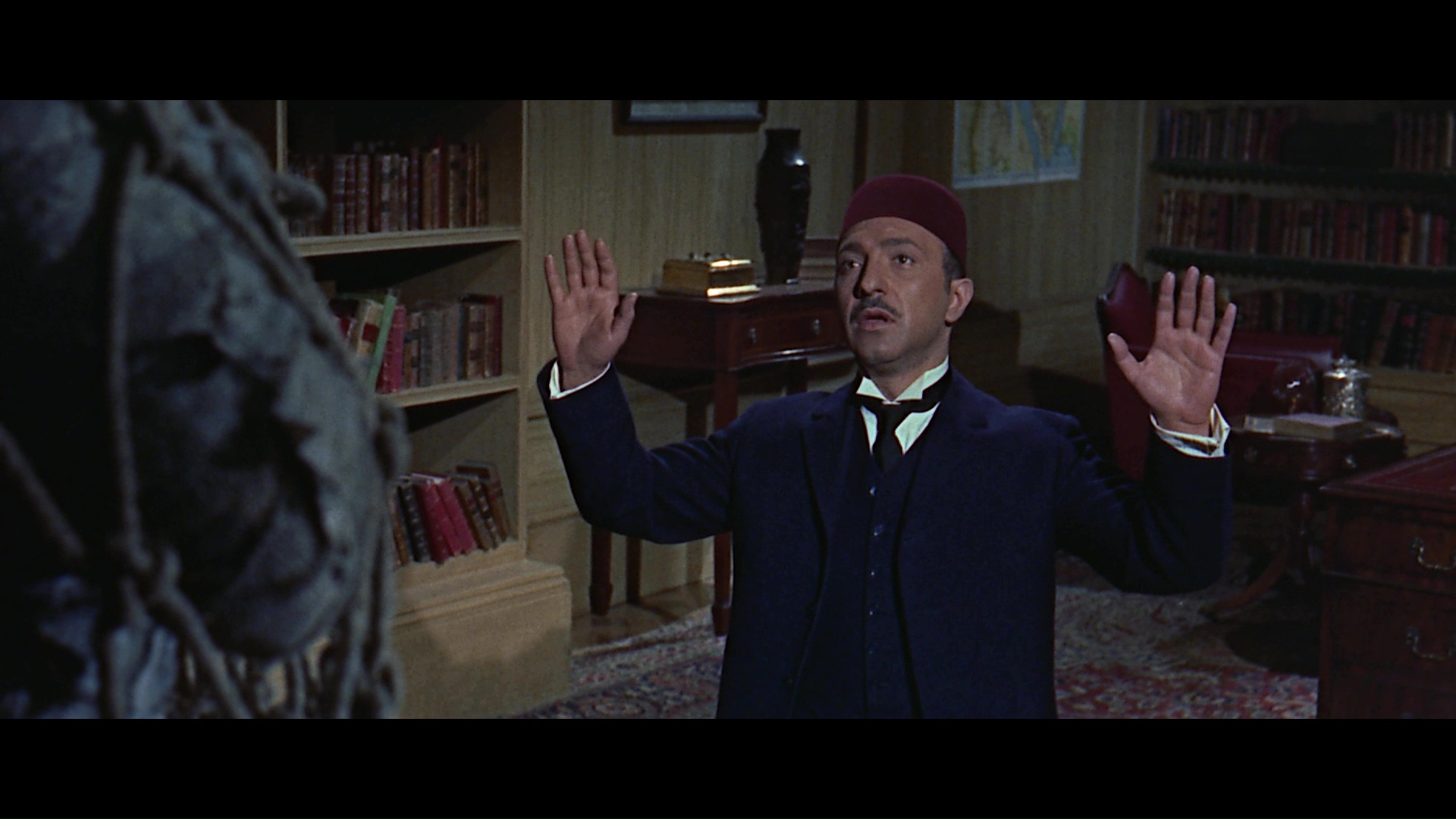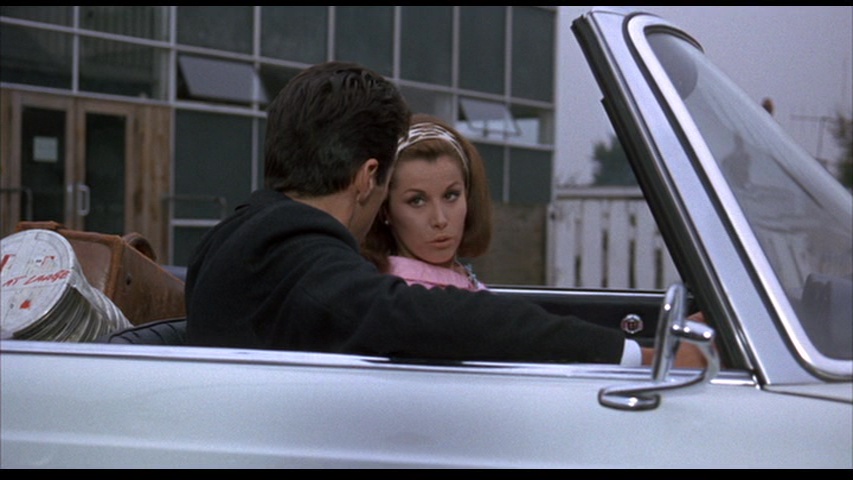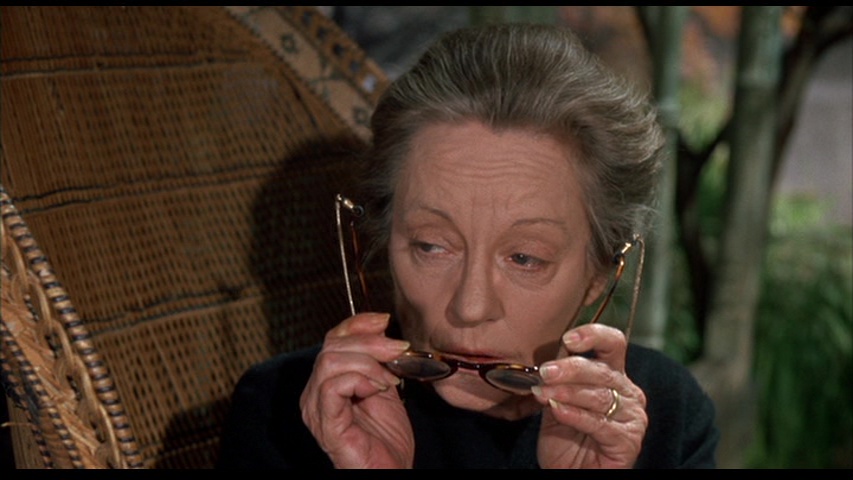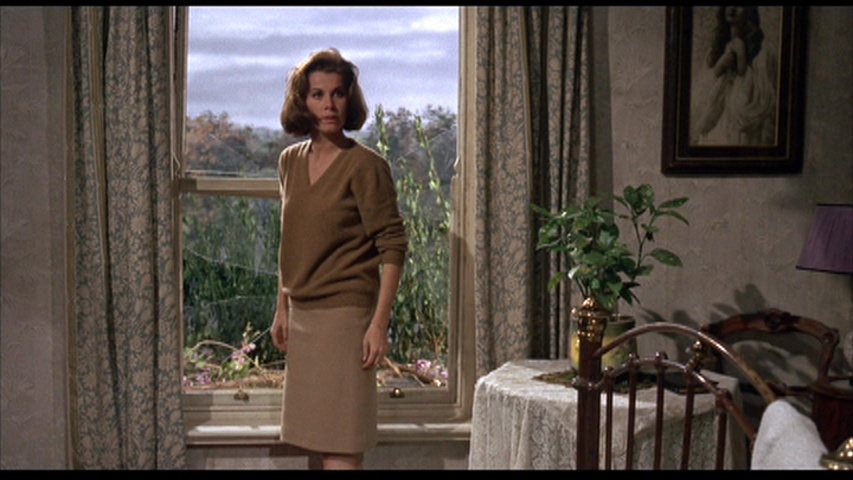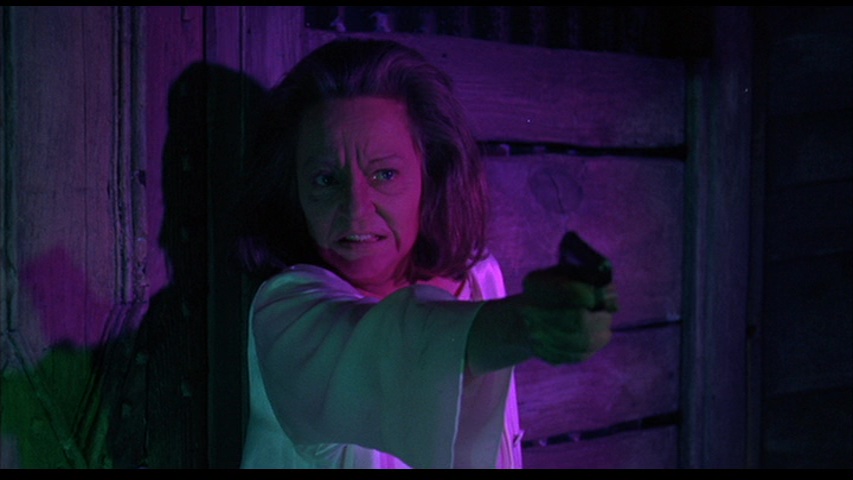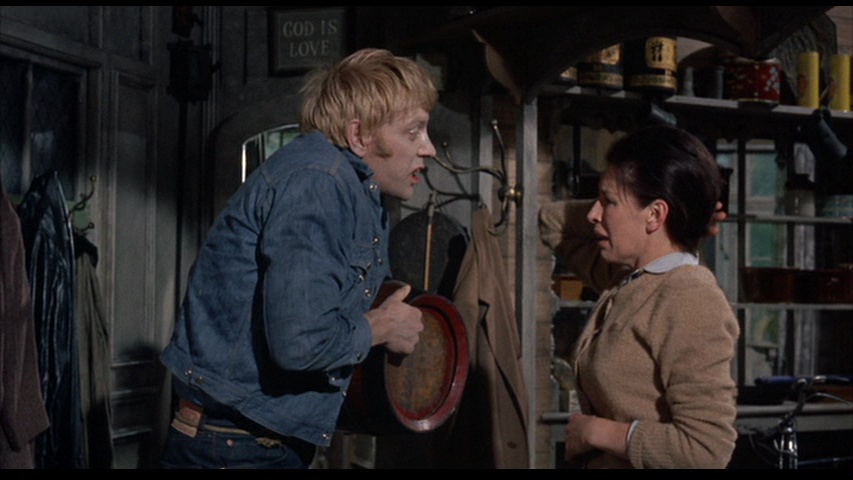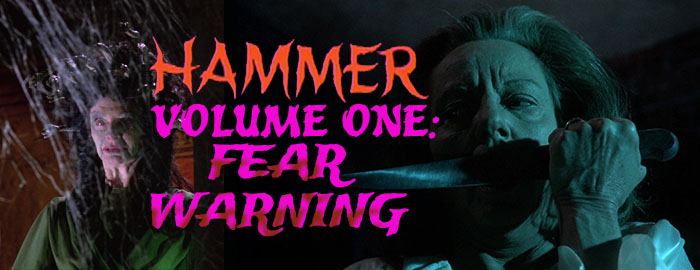
THE GORGON THE CURSE OF THE MUMMY'S TOMB MANIAC
B&W, 1963, 86 mins. 22 secs.
Directed by Michael Carreras
Starring Kerwin Mathews, Nadia Gray, Donald Houston, Liliane Brousse, George Pastell
Indicator (Blu-ray) (UK R0 HD), Sony (DVD) (US R0 NTSC) / WS (2.35:1) (16:9)
Color, 1963, 83 mins. 26 secs.
Directed by Terence Fisher
Starring Christopher Lee, Peter Cushing, Barbara Shelley, Richard Pasco, Michael Goodliffe, Patrick Troughton
Indicator (Blu-ray) (UK R0 HD), Sony (DVD) (US R0 NTSC) / WS (1.66:1) (16:9), Mill Creek (Blu-ray) (US RA HD), Via Vision (Blu-ray & DVD) (Australia R0 HD/PAL) / WS (1.78:1) (16:9)
Color, 1964, 80 mins. 13 secs.
Directed by Michael Carreras
Starring Terence Morgan, Ronald Howard, Fred Clark
Indicator (Blu-ray) (UK R0 HD), Mill Creek (Blu-ray) (US RA HD), Sony (DVD) (US R0 NTSC) / WS (2.35:1) (16:9)
FANATIC (DIE! DIE! MY DARLING)
Color, 1965, 96 mins. 18 secs.
Directed by Silvio Narizzano
Starring Tallulah Bankhead, Stefanie Powers, Peter Vaughan, Maurice Kaufmann, Yootha Joyce, Donald Sutherland
Indicator (Blu-ray) (UK R0 HD), Sony (DVD) (US R0 NTSC) / WS (1.85:1) (16:9)
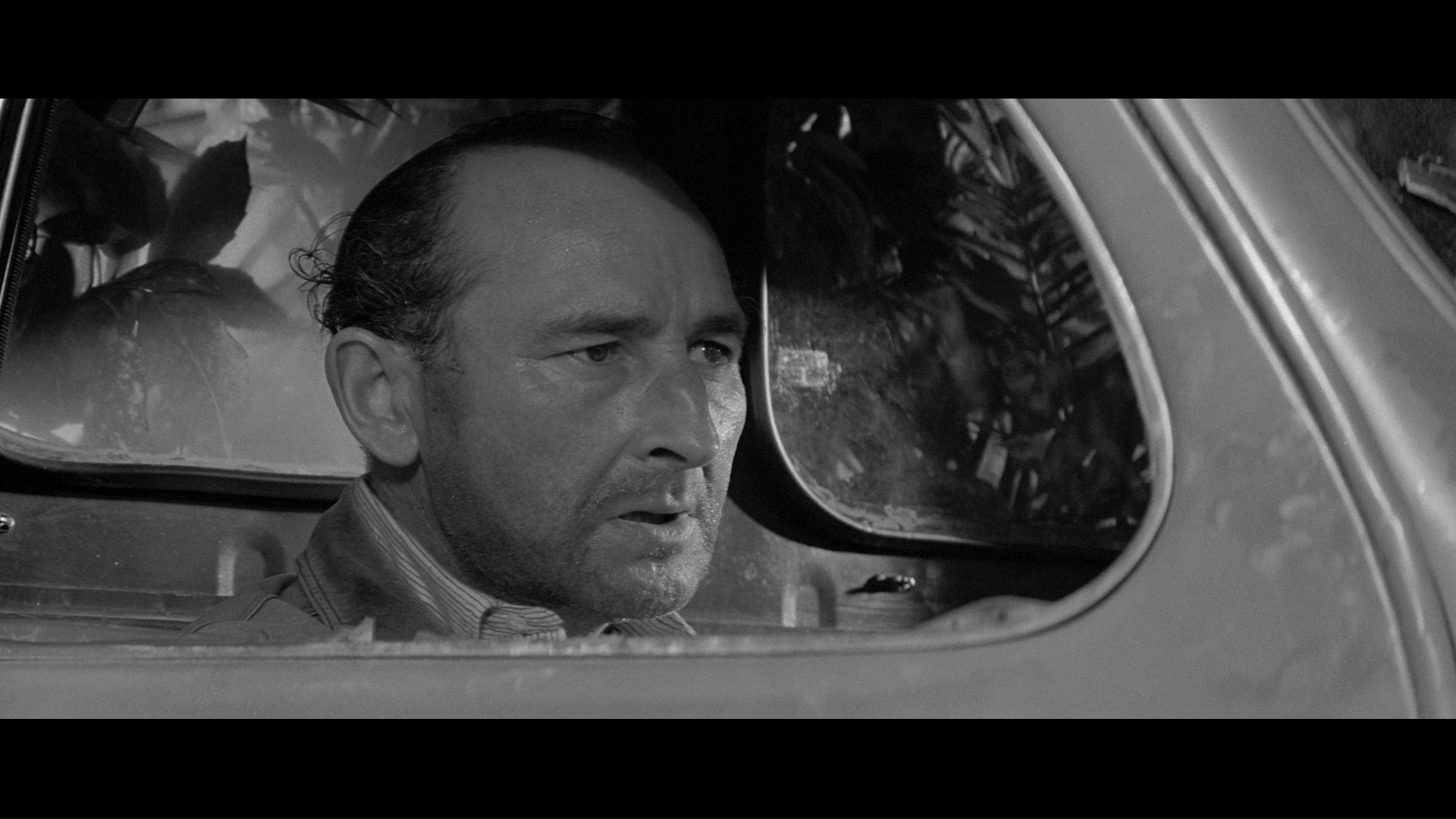 name in British horror that towers above
name in British horror that towers above 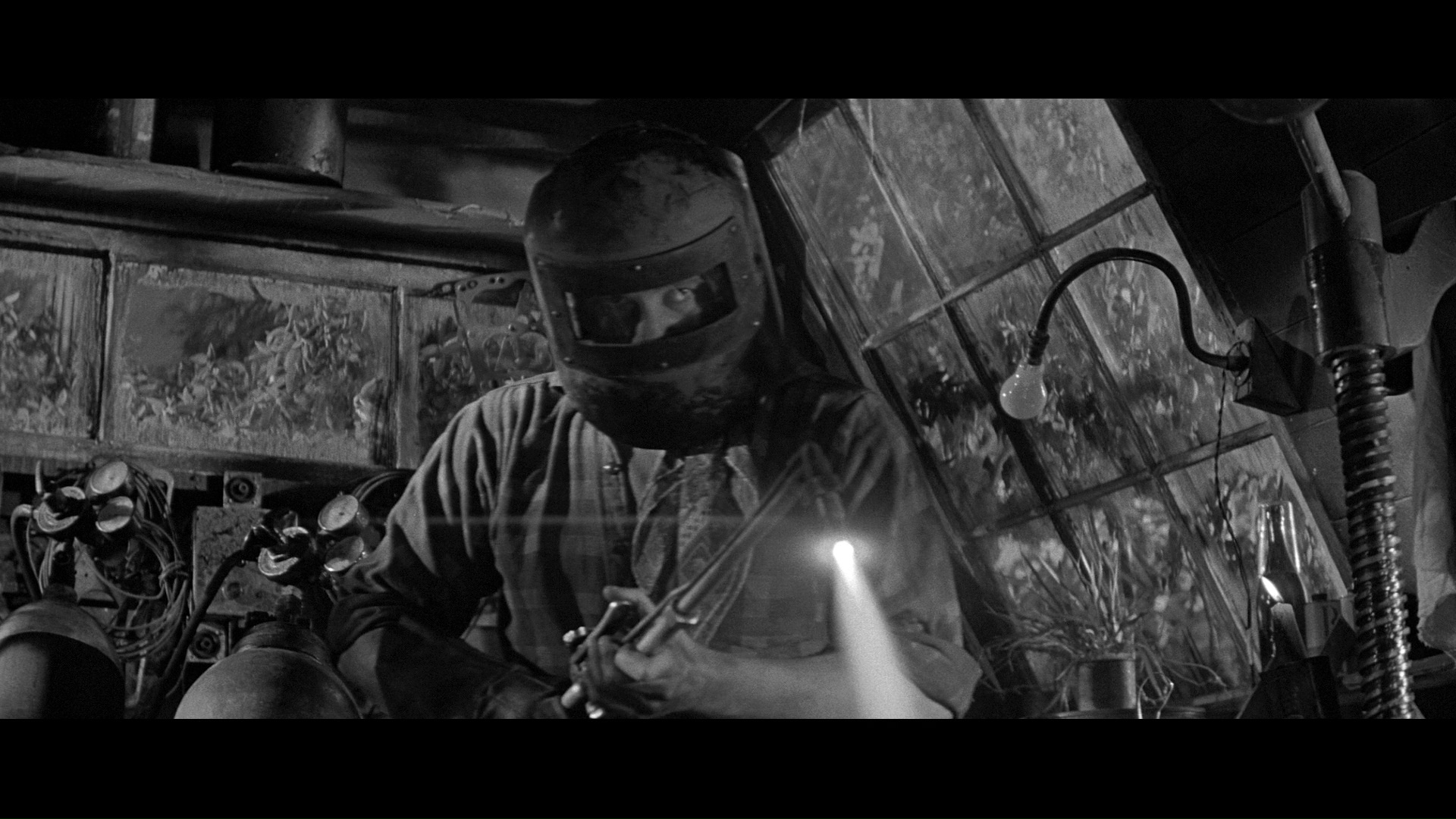 all others, Hammer Films has miraculously survived decades of critical lashings, fickle audience reception, and frequent scoffs that its atmospheric, dreamlike horror and suspense films were rendered obsolete in the new horror wave of the '70s. Still wildly popular and often imitated, Hammer set the pace for vibrant color versions of the screen's most famous monsters, it also did so much more -- as seen in Hammer Volume One: Fear Warning, the first set from UK label Indicator dedicated to some of its more fascinating outlier '60s projects split evenly here between its supernatural horrors and more down to earth suspense films.
all others, Hammer Films has miraculously survived decades of critical lashings, fickle audience reception, and frequent scoffs that its atmospheric, dreamlike horror and suspense films were rendered obsolete in the new horror wave of the '70s. Still wildly popular and often imitated, Hammer set the pace for vibrant color versions of the screen's most famous monsters, it also did so much more -- as seen in Hammer Volume One: Fear Warning, the first set from UK label Indicator dedicated to some of its more fascinating outlier '60s projects split evenly here between its supernatural horrors and more down to earth suspense films. 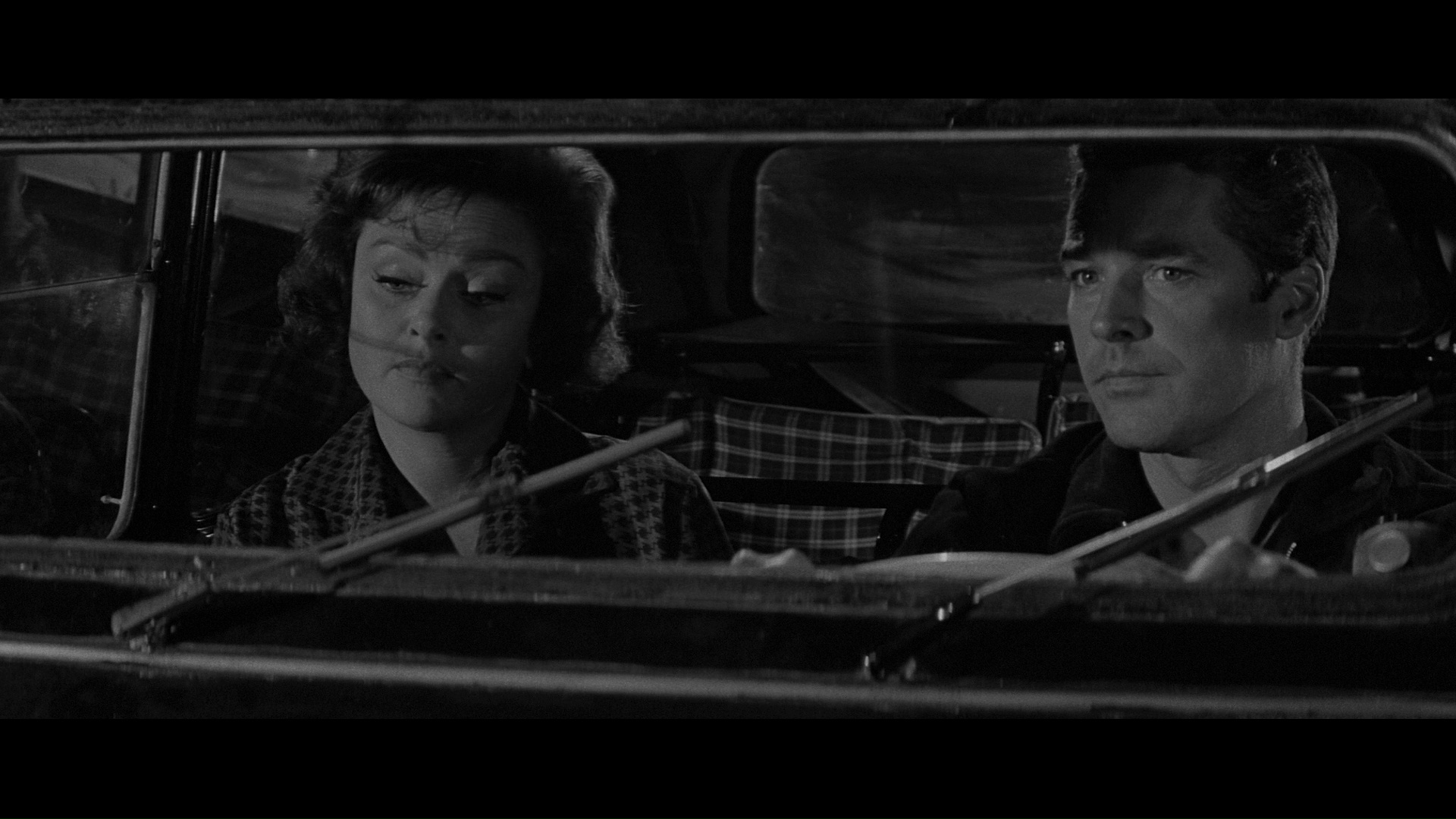 stepdaughter, Annette (Brousse). As we already know from the prologue, four years earlier Annette was attacked by a sexual predator who ended up on the wrong end of her dad's
stepdaughter, Annette (Brousse). As we already know from the prologue, four years earlier Annette was attacked by a sexual predator who ended up on the wrong end of her dad's 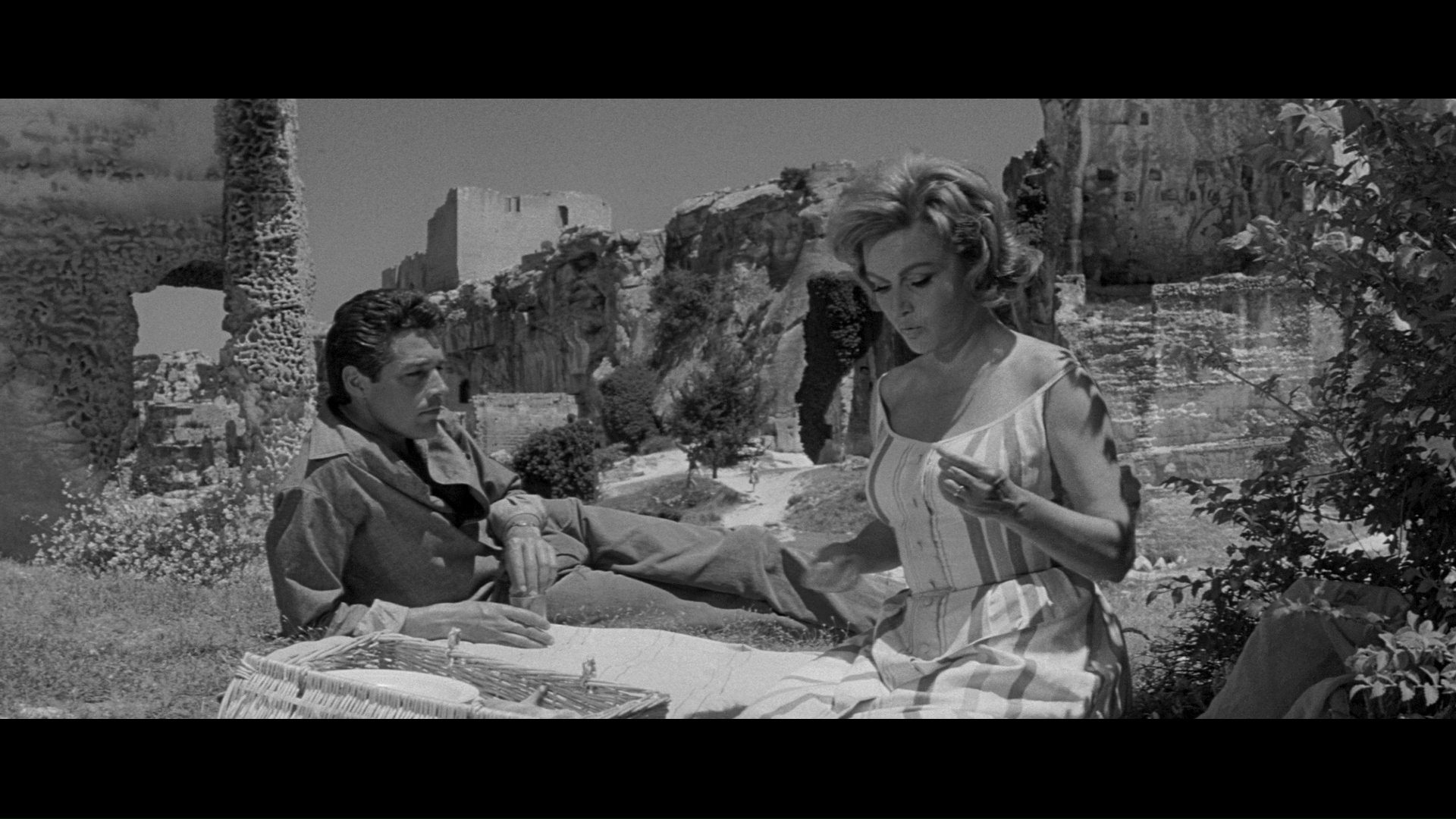 blowtorch, and now papa (Houston) has been locked away in the neighborhood's mental institution. Now Eve thinks he deserves to be sprung to enjoy life among polite society again, but several corkscrew twists lie in store.
blowtorch, and now papa (Houston) has been locked away in the neighborhood's mental institution. Now Eve thinks he deserves to be sprung to enjoy life among polite society again, but several corkscrew twists lie in store. 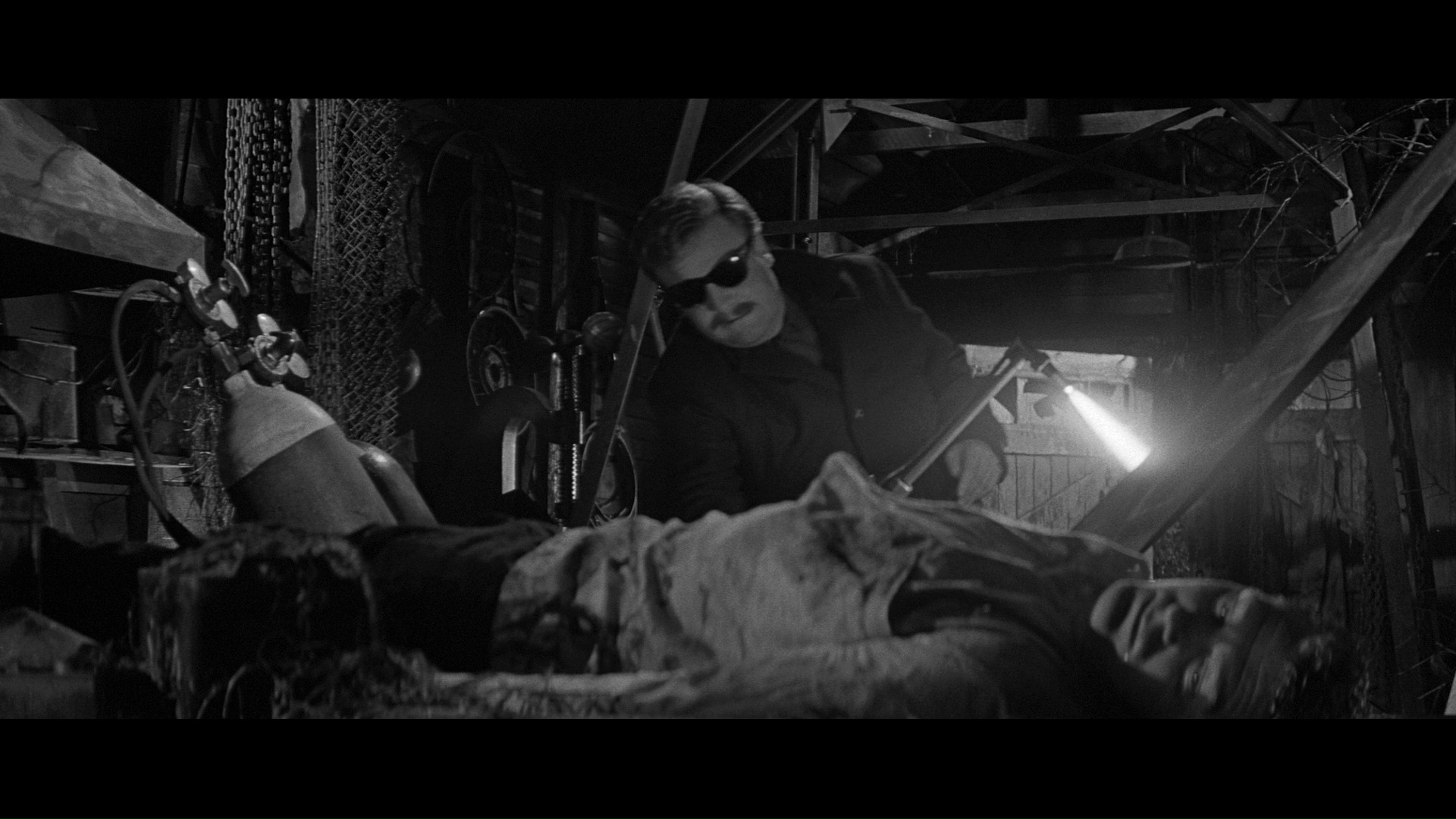 a beautiful sense of depth; nice, deep black levels give the shadowy interior scenes a nice boost in atmosphere, too. As with the other films in this set, the LPCM English mono
a beautiful sense of depth; nice, deep black levels give the shadowy interior scenes a nice boost in atmosphere, too. As with the other films in this set, the LPCM English mono 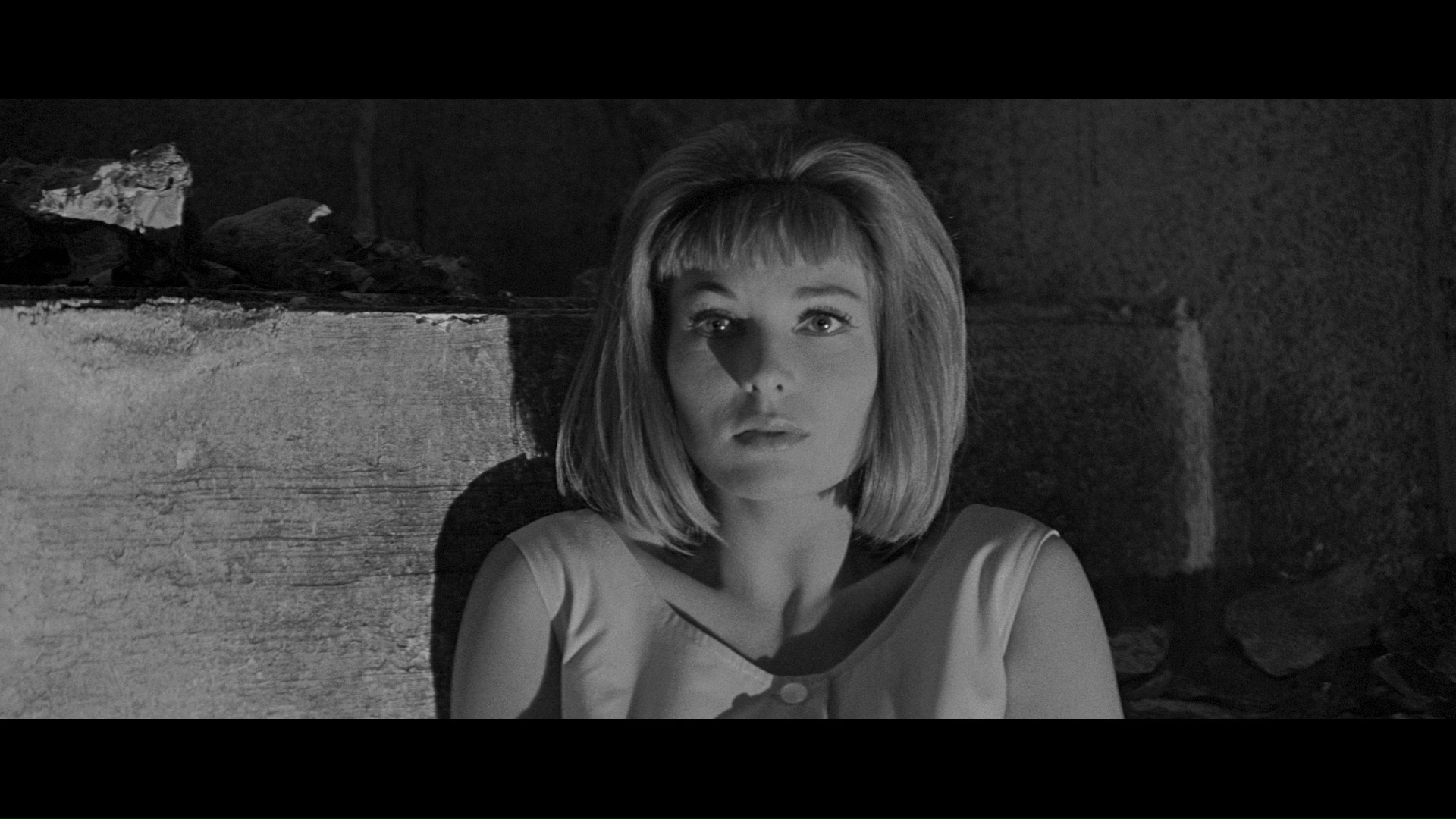 audio (with optional English SDH subtitles) sounds pristine. On the extras side, "White-Hot Terror: Inside Maniac" (10m59s) offers a history of the film from its origins as a Sangster script called Time of the Fire (already moving along before Scream of Fear was released) through its curious tonal shifts and striking look via its MegaScope compositions, with author Jonathan Rigby and cultural historian John J. Johnston providing most of the insights along with narration by Claire Louise Amias. (All three return on the other discs in this set as well.) "Hammer's Women: Nadia Gray" (7m51s) features a Lindsay Anne Hallam appraisal of the Romanian-born actress who also appeared in such films as La Dolce Vita and moved on to the more femme fatale demands of her role here. Focus puller Trevor Wrenn and clapper loader Ray Andrew shares their own memories of the film (5m9s) including quite a bit of socializing and drinking as well as the demands of housing the cast and crew in different locations in the small French village location. The theatrical trailer, a gallery of promotional material, and a separate batch of great on-set photos from Sangster's collection.
audio (with optional English SDH subtitles) sounds pristine. On the extras side, "White-Hot Terror: Inside Maniac" (10m59s) offers a history of the film from its origins as a Sangster script called Time of the Fire (already moving along before Scream of Fear was released) through its curious tonal shifts and striking look via its MegaScope compositions, with author Jonathan Rigby and cultural historian John J. Johnston providing most of the insights along with narration by Claire Louise Amias. (All three return on the other discs in this set as well.) "Hammer's Women: Nadia Gray" (7m51s) features a Lindsay Anne Hallam appraisal of the Romanian-born actress who also appeared in such films as La Dolce Vita and moved on to the more femme fatale demands of her role here. Focus puller Trevor Wrenn and clapper loader Ray Andrew shares their own memories of the film (5m9s) including quite a bit of socializing and drinking as well as the demands of housing the cast and crew in different locations in the small French village location. The theatrical trailer, a gallery of promotional material, and a separate batch of great on-set photos from Sangster's collection. 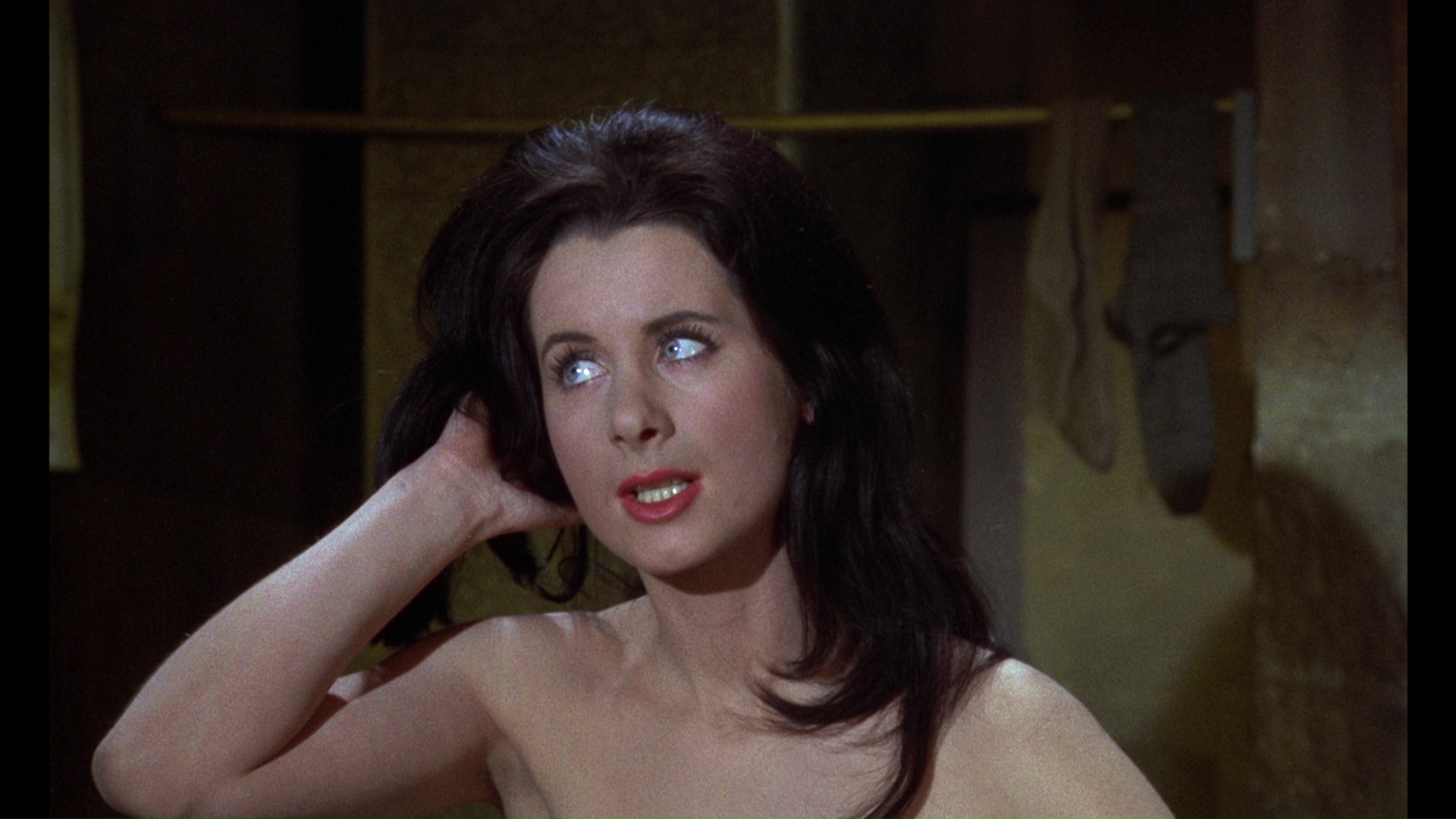 in the set, The Gorgon, has gradually come to be regarded as one of Hammer's crown jewels and a formidable achievement in color horror filmmaking from one of the greatest English horror filmmakers, Terence Fisher. Drawing on elements from Greek mythology transposed to a turn of the 20th century German town called
in the set, The Gorgon, has gradually come to be regarded as one of Hammer's crown jewels and a formidable achievement in color horror filmmaking from one of the greatest English horror filmmakers, Terence Fisher. Drawing on elements from Greek mythology transposed to a turn of the 20th century German town called 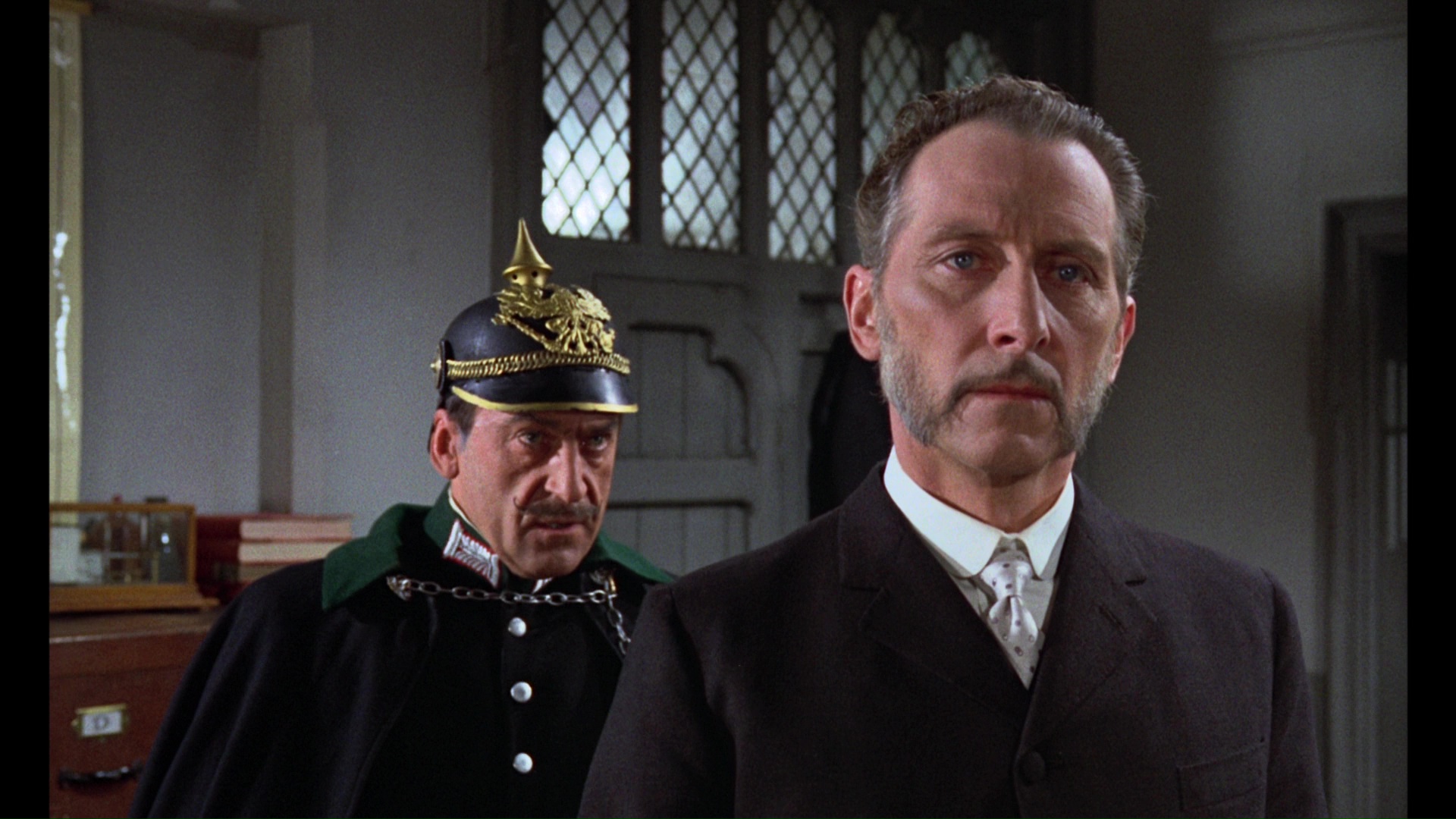 Vandorf. When a young pregnant village girl ends up dead in the forest and her lover, a painter, is found later hanging from a tree, the local powers that be declare it a murder-suicide... despite the fact that the dead girl was turned to stone, and everyone seems eager to hush up a deadly secret. The boy's father (Goodliffe) determines to clear his name despite the lack of forthcoming information from the medical examiner, Dr. Namaroff (Cushing), whose assistant, Carla (Shelley), is more than a little alarmed at all the secrecy. Soon reinforcements arrive in the form of the deceased's brother, Paul (Pasco), who provides some legwork to untangling the mystery. All of these strange occurrences lead to tales that the one surviving sister of the three mythological gorgons, Megaera, made her home in the area centuries before... but could she still be alive and walking among them?
Vandorf. When a young pregnant village girl ends up dead in the forest and her lover, a painter, is found later hanging from a tree, the local powers that be declare it a murder-suicide... despite the fact that the dead girl was turned to stone, and everyone seems eager to hush up a deadly secret. The boy's father (Goodliffe) determines to clear his name despite the lack of forthcoming information from the medical examiner, Dr. Namaroff (Cushing), whose assistant, Carla (Shelley), is more than a little alarmed at all the secrecy. Soon reinforcements arrive in the form of the deceased's brother, Paul (Pasco), who provides some legwork to untangling the mystery. All of these strange occurrences lead to tales that the one surviving sister of the three mythological gorgons, Megaera, made her home in the area centuries before... but could she still be alive and walking among them? 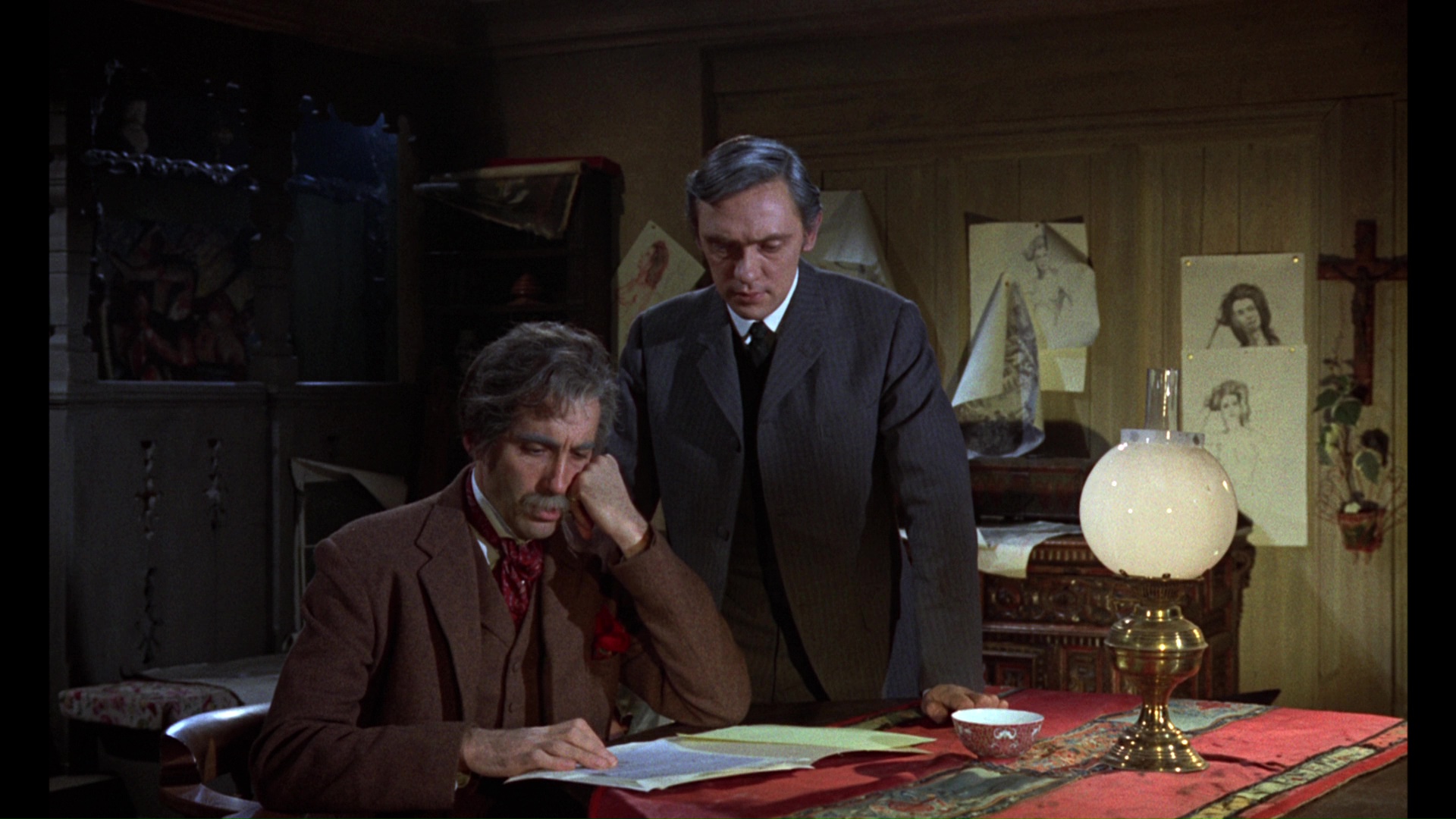 features more than enough mood and visual panache to overcome what would be crippling shortcomings in other horror films (mainly some famously inadequate gorgon effects in the final scenes and a plot that doesn't always make a ton of sense). The fairy tale aspects have been frequently noted over the years, and with good reason; along with Brides of Dracula and Kiss of the Vampire, it has one of the most potent depictions of an otherworldly European village suffocating under the forces of darkness.
features more than enough mood and visual panache to overcome what would be crippling shortcomings in other horror films (mainly some famously inadequate gorgon effects in the final scenes and a plot that doesn't always make a ton of sense). The fairy tale aspects have been frequently noted over the years, and with good reason; along with Brides of Dracula and Kiss of the Vampire, it has one of the most potent depictions of an otherworldly European village suffocating under the forces of darkness. 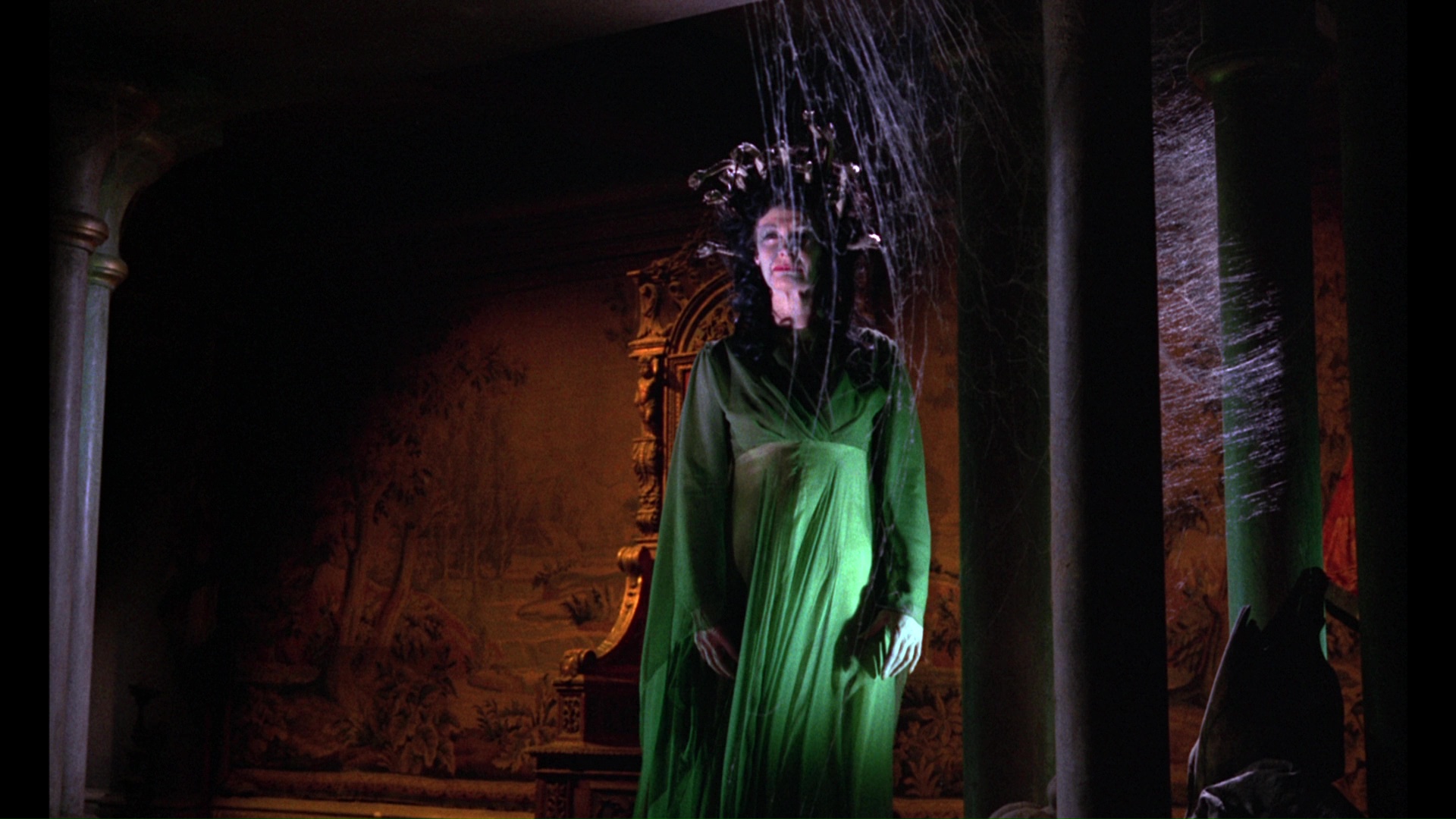 first Hammer films transferred in HD for its initial airings on the defunct and much-missed Monsters HD channel in 2004. That same HD master made its DVD bow in 2008 from Sony as part of the Hammer Films: Icons of Horror Collection set along with Scream of Fear, The Two Faces of Dr. Jekyll, and The Curse of the Mummy's Tomb. Eventually the film (and several other Hammers) ended up sublicensed to Mill Creek in the U.S., first for a budget Hammer Films Vol. 1 collection in 2015 and then for a Blu-ray double feature with Two Faces of Dr. Jekyll in 2016 featuring a reasonably good encoding and lossy Dolby Digital audio. However, the Indicator is really the way to go as it's the only HD option that's correctly framed (much more image info in the 1.66:1 frame versus the others at 1.78:1), plus it pumps the bit rate much higher and sports lossy audio. Not surprisingly, this one comes with some of the meatiest supplements in the set including the one audio commentary in the batch, by Daughters of Darkness’ Samm Deighan and Kat Ellinger. They tackle the film's depiction of that old horror staple, monstrous female sexuality, as well as its proud
first Hammer films transferred in HD for its initial airings on the defunct and much-missed Monsters HD channel in 2004. That same HD master made its DVD bow in 2008 from Sony as part of the Hammer Films: Icons of Horror Collection set along with Scream of Fear, The Two Faces of Dr. Jekyll, and The Curse of the Mummy's Tomb. Eventually the film (and several other Hammers) ended up sublicensed to Mill Creek in the U.S., first for a budget Hammer Films Vol. 1 collection in 2015 and then for a Blu-ray double feature with Two Faces of Dr. Jekyll in 2016 featuring a reasonably good encoding and lossy Dolby Digital audio. However, the Indicator is really the way to go as it's the only HD option that's correctly framed (much more image info in the 1.66:1 frame versus the others at 1.78:1), plus it pumps the bit rate much higher and sports lossy audio. Not surprisingly, this one comes with some of the meatiest supplements in the set including the one audio commentary in the batch, by Daughters of Darkness’ Samm Deighan and Kat Ellinger. They tackle the film's depiction of that old horror staple, monstrous female sexuality, as well as its proud 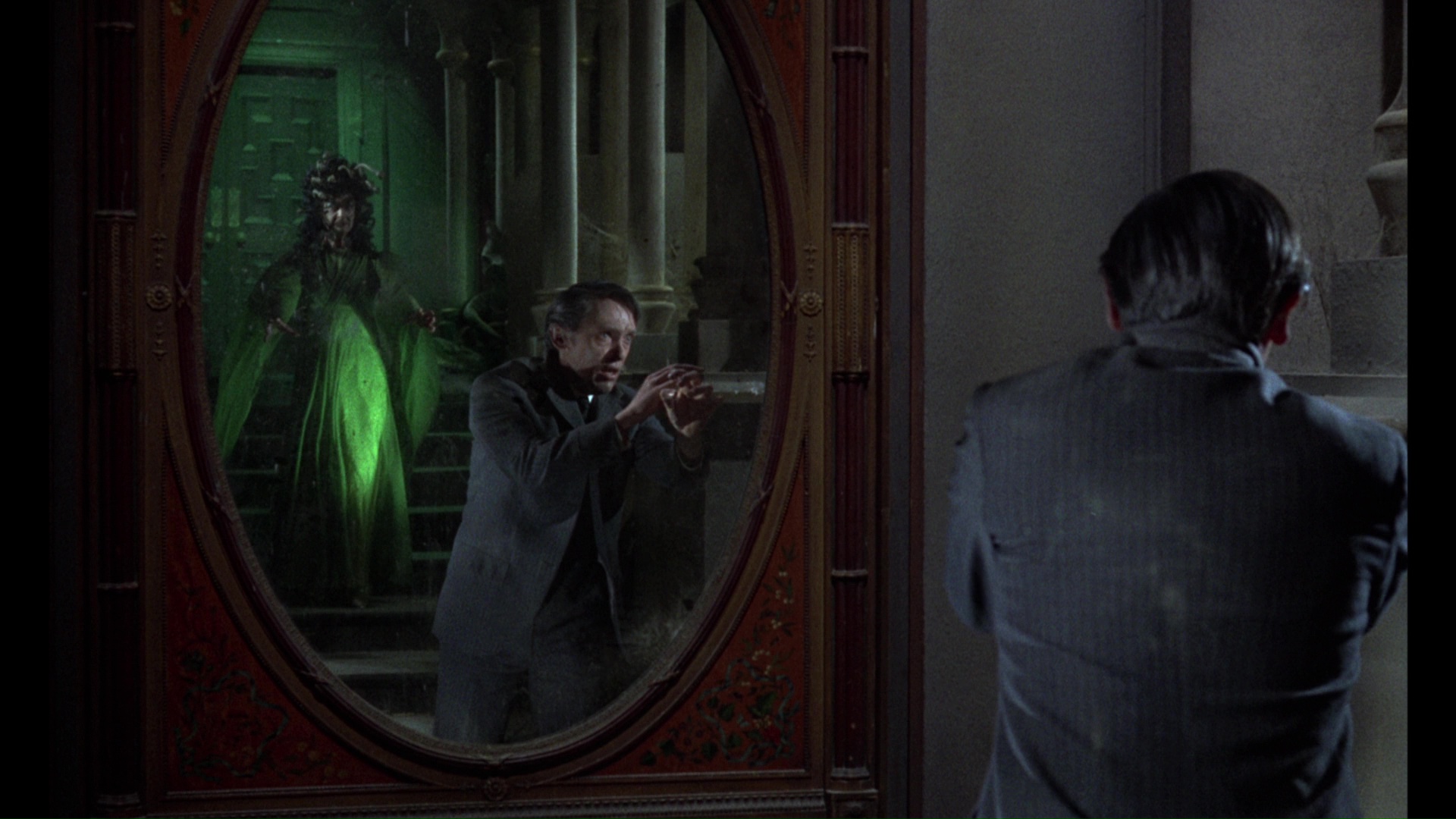 place in the tiny subsection of horror movies inspired by Greek mythology. It's a great track as always for them, though it gives the impression of being recorded in separate sessions without direct interaction between the two. The Rigby/Johnston/Amias gang returns for "Heart of Stone: Inside The Gorgon" (14m1s), starting off with the film's troubled genesis (including chagrined early writer John Gilling), the money-deprived special effects, and the many merits of the finished product as a refreshing change of pace in the Hammer monster canon. "Hammer's Women: Barbara Shelley" (9m28s) features Patricia MacCormack articulating the appeal of the British horror icon who made a tremendous impression in Dracula, Prince of Darkness with another rich role in Rasputin the Mad Monk. Like the commentary, she notes the strangeness of using the name and characteristic of a Greek fury rather than a gorgon for the titular menace, but few audiences were likely to notice at the time. Actor and filmmaker Matthew Holness from the
place in the tiny subsection of horror movies inspired by Greek mythology. It's a great track as always for them, though it gives the impression of being recorded in separate sessions without direct interaction between the two. The Rigby/Johnston/Amias gang returns for "Heart of Stone: Inside The Gorgon" (14m1s), starting off with the film's troubled genesis (including chagrined early writer John Gilling), the money-deprived special effects, and the many merits of the finished product as a refreshing change of pace in the Hammer monster canon. "Hammer's Women: Barbara Shelley" (9m28s) features Patricia MacCormack articulating the appeal of the British horror icon who made a tremendous impression in Dracula, Prince of Darkness with another rich role in Rasputin the Mad Monk. Like the commentary, she notes the strangeness of using the name and characteristic of a Greek fury rather than a gorgon for the titular menace, but few audiences were likely to notice at the time. Actor and filmmaker Matthew Holness from the 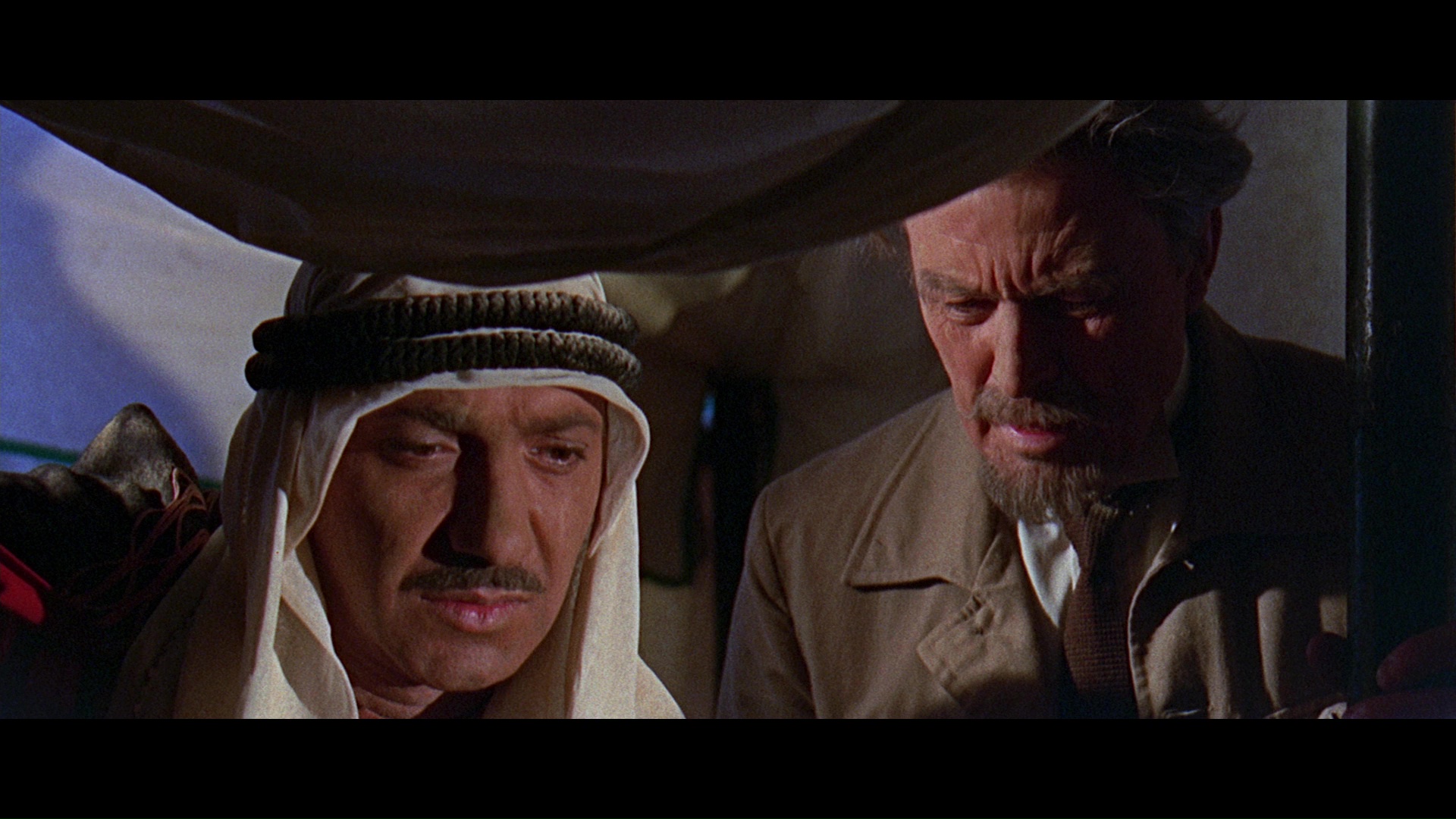 astounding Garth Marenghi's Darkplace offers a fine video discussion (14m51s) focusing on the appeal of Fisher's cinema and this film's creepy slot in his output for the studio, while other goodies include the theatrical trailer, a 1977 comic-strip adaptation by Scot Goodall and Gorgin & Coyas from House of Hammer magazine, and a gallery with over 100 stills and various promotional items.
astounding Garth Marenghi's Darkplace offers a fine video discussion (14m51s) focusing on the appeal of Fisher's cinema and this film's creepy slot in his output for the studio, while other goodies include the theatrical trailer, a 1977 comic-strip adaptation by Scot Goodall and Gorgin & Coyas from House of Hammer magazine, and a gallery with over 100 stills and various promotional items. 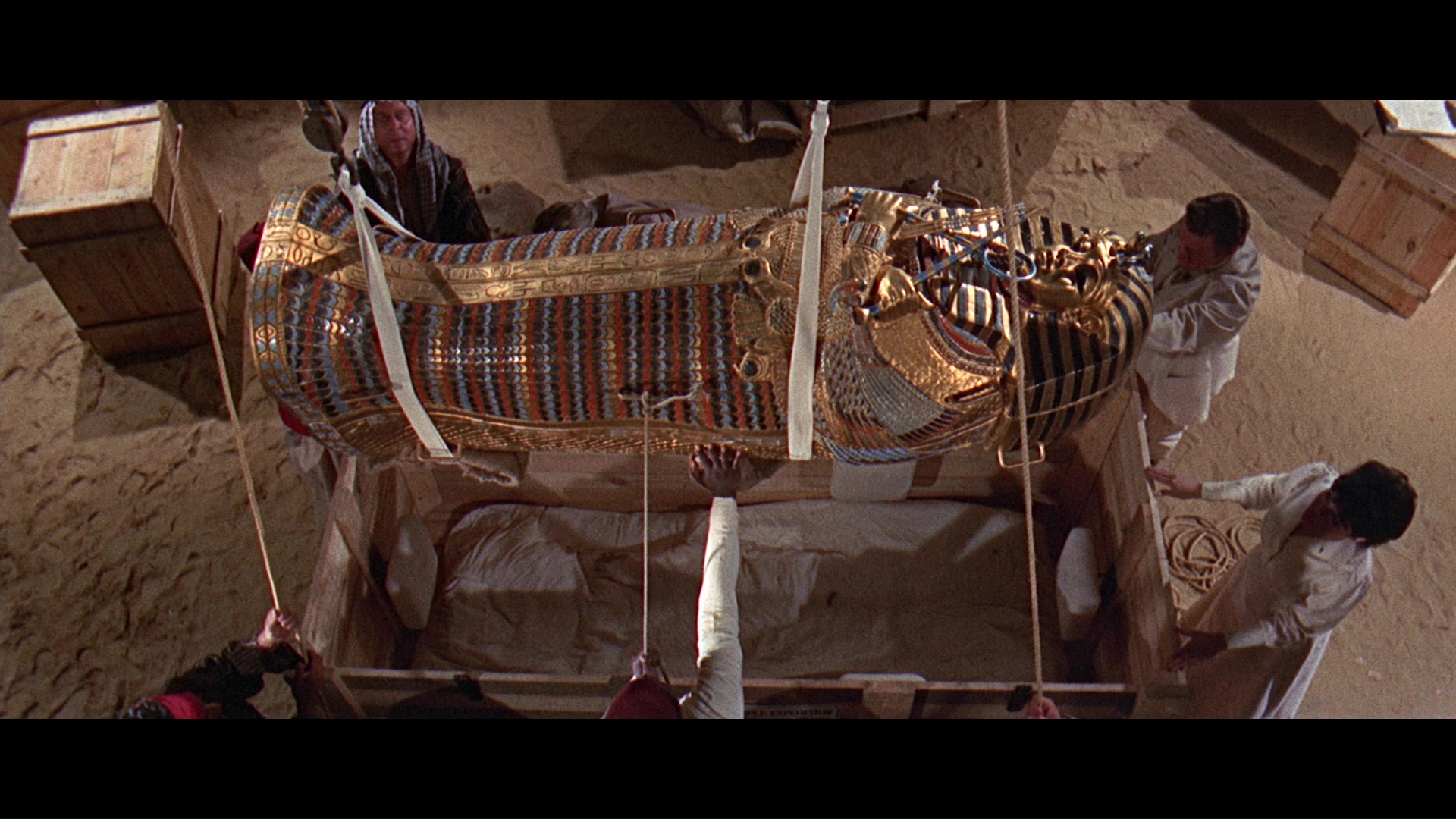 longest period of time -- five years -- to make a second outing for a wrapped Egyptian menace stomping around London. The Curse of the Mummy's Tomb drops the vivid colors and doomed romanticism of Terence Fisher's original The Mummy in favor of functional scope compositions and lots of Egyptian flavor catering to travelogue tastes, albeit with a few jolting moments of violence (including a hand amputation and a pretty shocking punishment by clothed foot) to keep things appealing to modern audiences. Like Maniac, this was directed (and co-written under an alias) by onetime Hammer executive Michael Carreras, who would wind up taking over Hammer's fourth and final mummy film, Blood from the Mummy's Tomb, in 1971 after the death of director Seth Holt. The plot here is basically a rehash of the familiar formula as three Englishmen go tromping through Egypt on an
longest period of time -- five years -- to make a second outing for a wrapped Egyptian menace stomping around London. The Curse of the Mummy's Tomb drops the vivid colors and doomed romanticism of Terence Fisher's original The Mummy in favor of functional scope compositions and lots of Egyptian flavor catering to travelogue tastes, albeit with a few jolting moments of violence (including a hand amputation and a pretty shocking punishment by clothed foot) to keep things appealing to modern audiences. Like Maniac, this was directed (and co-written under an alias) by onetime Hammer executive Michael Carreras, who would wind up taking over Hammer's fourth and final mummy film, Blood from the Mummy's Tomb, in 1971 after the death of director Seth Holt. The plot here is basically a rehash of the familiar formula as three Englishmen go tromping through Egypt on an 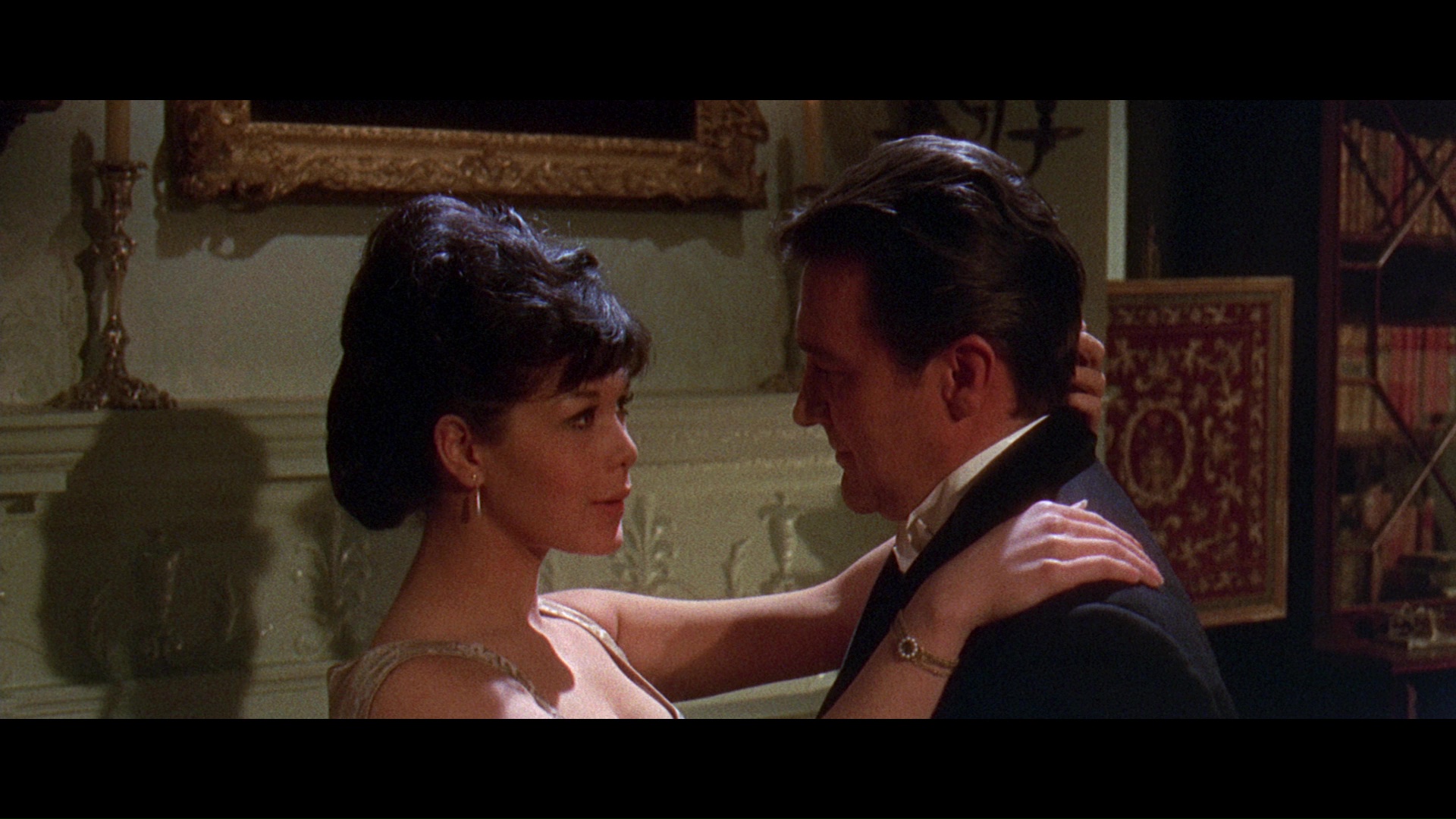 expedition to pilfer a recently discovered tomb. Along with uncovered treasures, they decide to haul a mummy back with them and present their findings, represented mainly by Egyptologist and nominal hero John Bray (Howard) and the "more than just decorative" Annette (Roland), Bray's fiancée and assistant. Of course, it doesn't take long for a shadowy, exotic fellow named Adam (Morgan) to play a role in reviving the mummy, a once-powerful pharaoh, who isn't pleased with American showman Alexander King (Clark) and all of that disrespect to his eternal resting place.
expedition to pilfer a recently discovered tomb. Along with uncovered treasures, they decide to haul a mummy back with them and present their findings, represented mainly by Egyptologist and nominal hero John Bray (Howard) and the "more than just decorative" Annette (Roland), Bray's fiancée and assistant. Of course, it doesn't take long for a shadowy, exotic fellow named Adam (Morgan) to play a role in reviving the mummy, a once-powerful pharaoh, who isn't pleased with American showman Alexander King (Clark) and all of that disrespect to his eternal resting place. 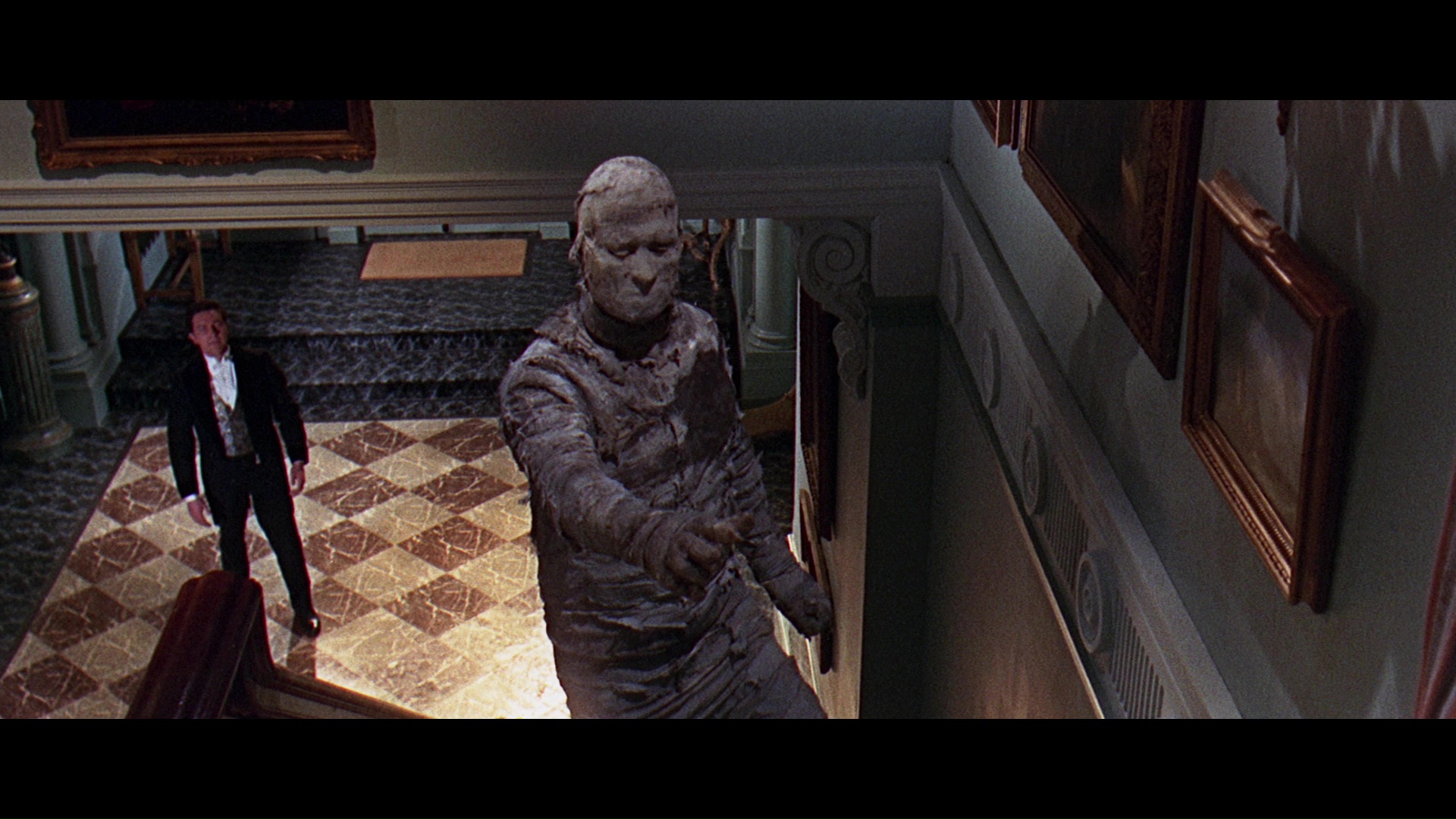 appeared at the top of any Hammer fan's list of favorites, Curse has been a reliable TV fixture for decades and has shown a great deal of endurance over the years. It's basically middle tier Hammer, perfectly functional and filled with enough grisly bits (including a pretty downbeat ending) to leave just enough of an impression to stick in your head for a little while. The first widescreen DVD appeared in that aforementioned Sony collection, followed by the Mill Creek set and a Blu-ray double feature crammed on a disc with The Revenge of Frankenstein (again looking okay considering but with lossy audio). The Indicator blasts that prior Blu-ray out of the water with a vastly superior presentation featuring much more robust colors, far more image info in the frame, and far less element damage -- not to mention more breathing room on the BD-50 disc and lossless audio, which makes a
appeared at the top of any Hammer fan's list of favorites, Curse has been a reliable TV fixture for decades and has shown a great deal of endurance over the years. It's basically middle tier Hammer, perfectly functional and filled with enough grisly bits (including a pretty downbeat ending) to leave just enough of an impression to stick in your head for a little while. The first widescreen DVD appeared in that aforementioned Sony collection, followed by the Mill Creek set and a Blu-ray double feature crammed on a disc with The Revenge of Frankenstein (again looking okay considering but with lossy audio). The Indicator blasts that prior Blu-ray out of the water with a vastly superior presentation featuring much more robust colors, far more image info in the frame, and far less element damage -- not to mention more breathing room on the BD-50 disc and lossless audio, which makes a 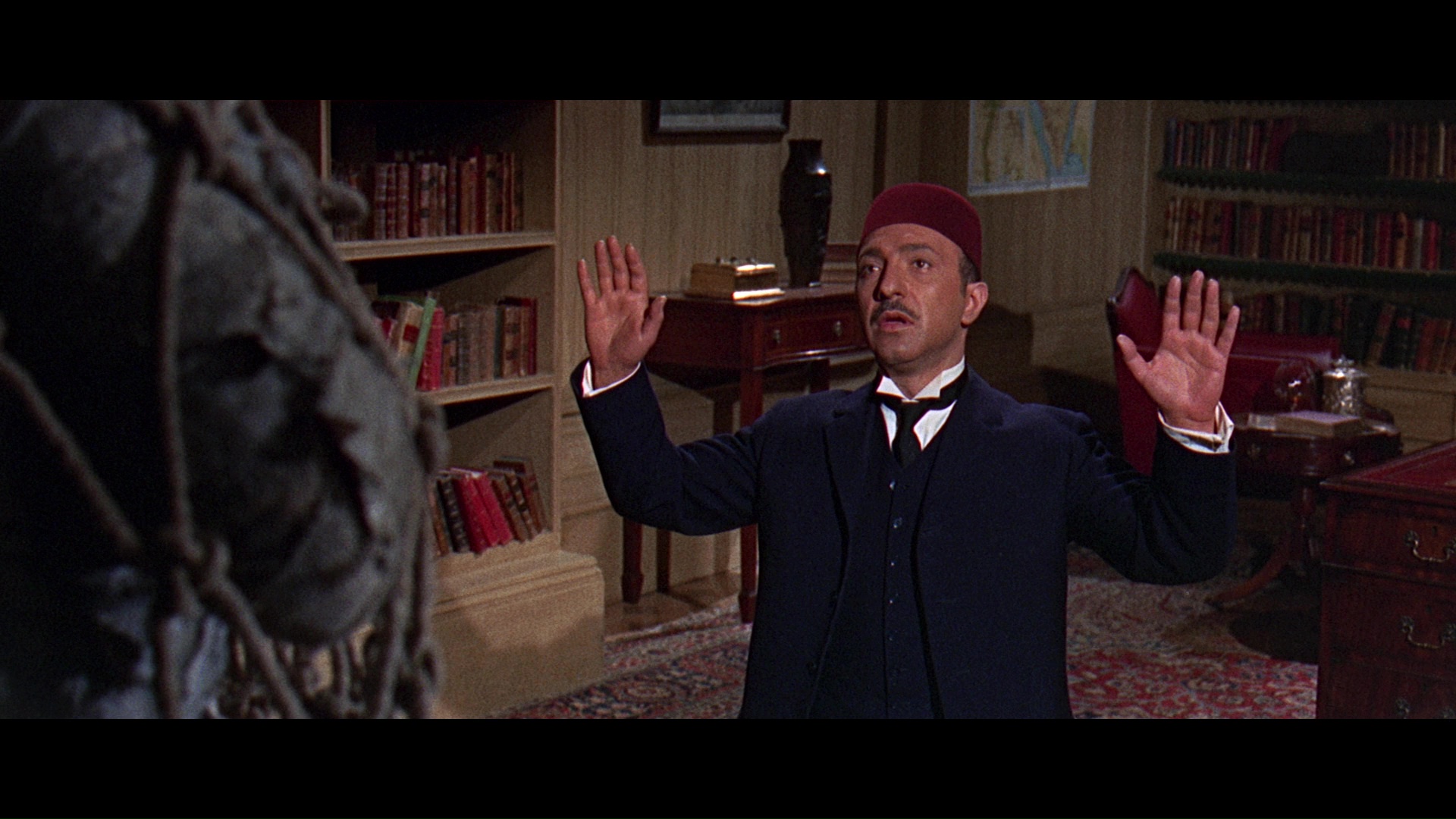 difference in this case as the soundtrack is actually quite impactful at times.
difference in this case as the soundtrack is actually quite impactful at times. 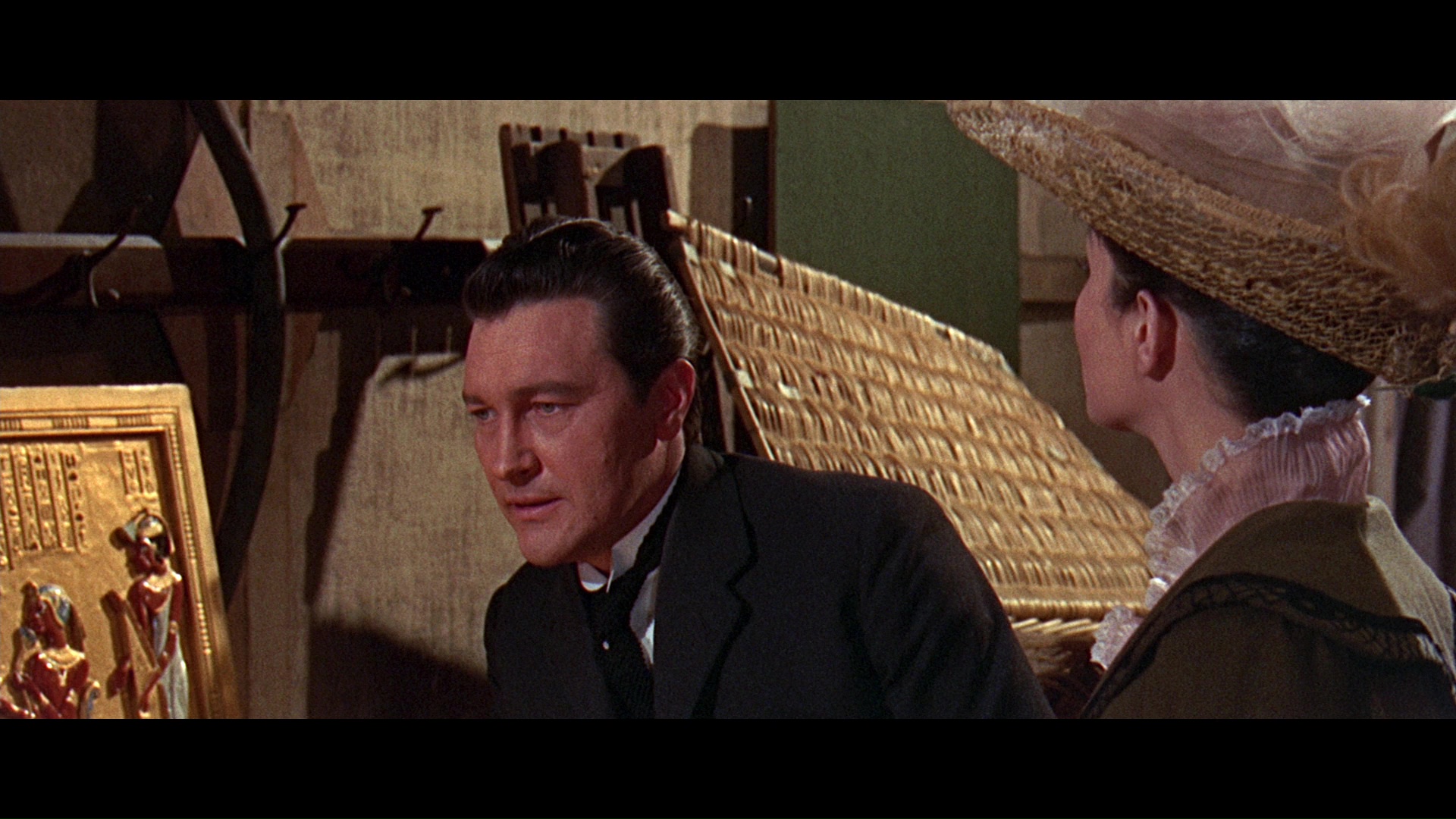 voice hardly ever heard (perhaps only in one brief appearance on The Avengers) and how she belongs to the tradition of Hammer glamour, which crossed over with her silent appearance in You Only Live Twice. There's entertainment aplenty in an interview with actor Michael McStay (5m59s), who plays the flashback pharaoh who becomes the mummy; don't miss his recollection about ad libbing some lines that wound up annoying some deaf viewers who could read lips or his reaction to see his realistic molded hand getting lopped off. Finally, composer Carlo Martelli briefly speaks for 4m12s about the various classical and preexisting pieces in the film (including chunks of Hammer's prior mummy score) without really going into his own contributions much at all. Also included are a silent, black-and-white Super 8 version (6m53s), the theatrical trailer, and a hefty gallery of stills and artwork that once
voice hardly ever heard (perhaps only in one brief appearance on The Avengers) and how she belongs to the tradition of Hammer glamour, which crossed over with her silent appearance in You Only Live Twice. There's entertainment aplenty in an interview with actor Michael McStay (5m59s), who plays the flashback pharaoh who becomes the mummy; don't miss his recollection about ad libbing some lines that wound up annoying some deaf viewers who could read lips or his reaction to see his realistic molded hand getting lopped off. Finally, composer Carlo Martelli briefly speaks for 4m12s about the various classical and preexisting pieces in the film (including chunks of Hammer's prior mummy score) without really going into his own contributions much at all. Also included are a silent, black-and-white Super 8 version (6m53s), the theatrical trailer, and a hefty gallery of stills and artwork that once 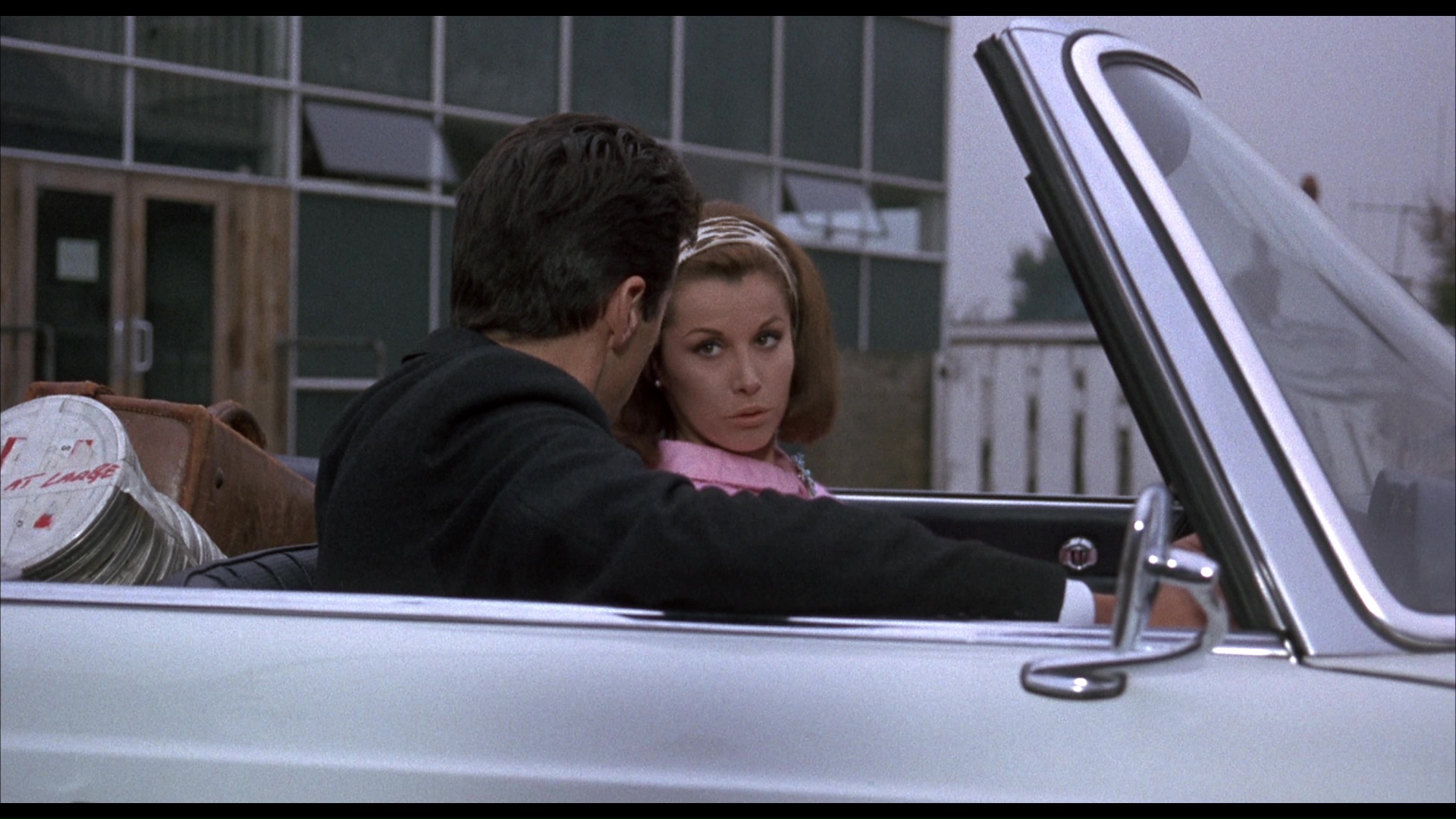 again numbers over 100 images.
again numbers over 100 images. 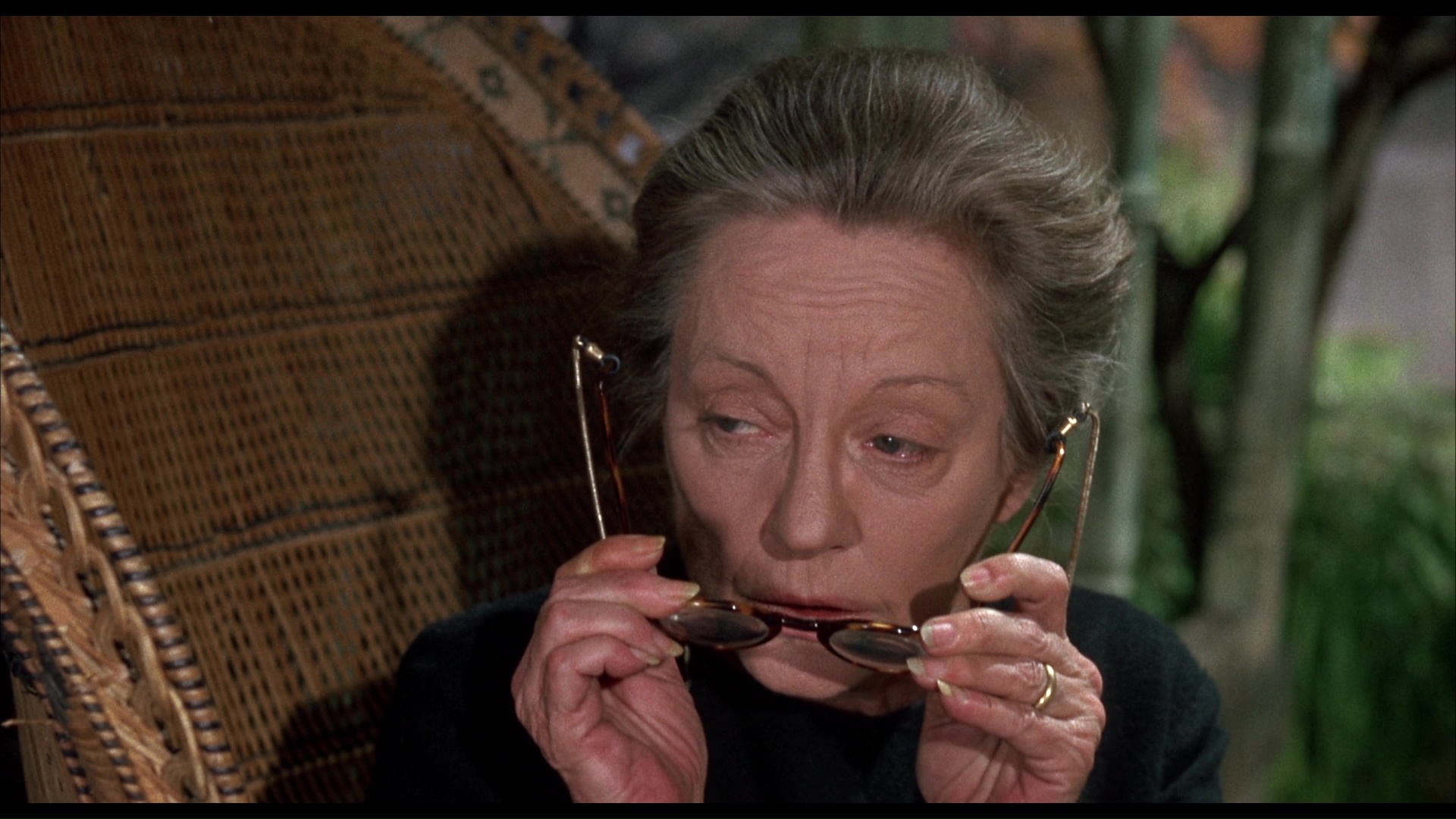 Bankhead had her last film role on screen in Fanatic, shown in the U.S. as Die! Die! My Darling and a stylish change of pace for Canadian-born director Silvio Narizzano, most famous for Georgy Girl. Stefanie Powers (who would also star in Hammer's last real entry in the thriller cycle, Crescendo, and went on to TV fame with Hart to Hart), stars as Patricia, a young woman about to marry London resident Alan (Kaufmann). However, she feels she has some unfinished business to attend to with the mother of her previous fiance, Stephen, who died before they could tie the knot. She goes to see his extremely religious mother, Mrs. Trefoile (Bankhead), who lives a secluded existence with two domestic staff members, Harry (Vaughan) and Anna (Joyce). As it turns out, the grieving mother has a bone to pick with Patricia and soon has her confined within the house against her will... but more twists are still to come.
Bankhead had her last film role on screen in Fanatic, shown in the U.S. as Die! Die! My Darling and a stylish change of pace for Canadian-born director Silvio Narizzano, most famous for Georgy Girl. Stefanie Powers (who would also star in Hammer's last real entry in the thriller cycle, Crescendo, and went on to TV fame with Hart to Hart), stars as Patricia, a young woman about to marry London resident Alan (Kaufmann). However, she feels she has some unfinished business to attend to with the mother of her previous fiance, Stephen, who died before they could tie the knot. She goes to see his extremely religious mother, Mrs. Trefoile (Bankhead), who lives a secluded existence with two domestic staff members, Harry (Vaughan) and Anna (Joyce). As it turns out, the grieving mother has a bone to pick with Patricia and soon has her confined within the house against her will... but more twists are still to come. 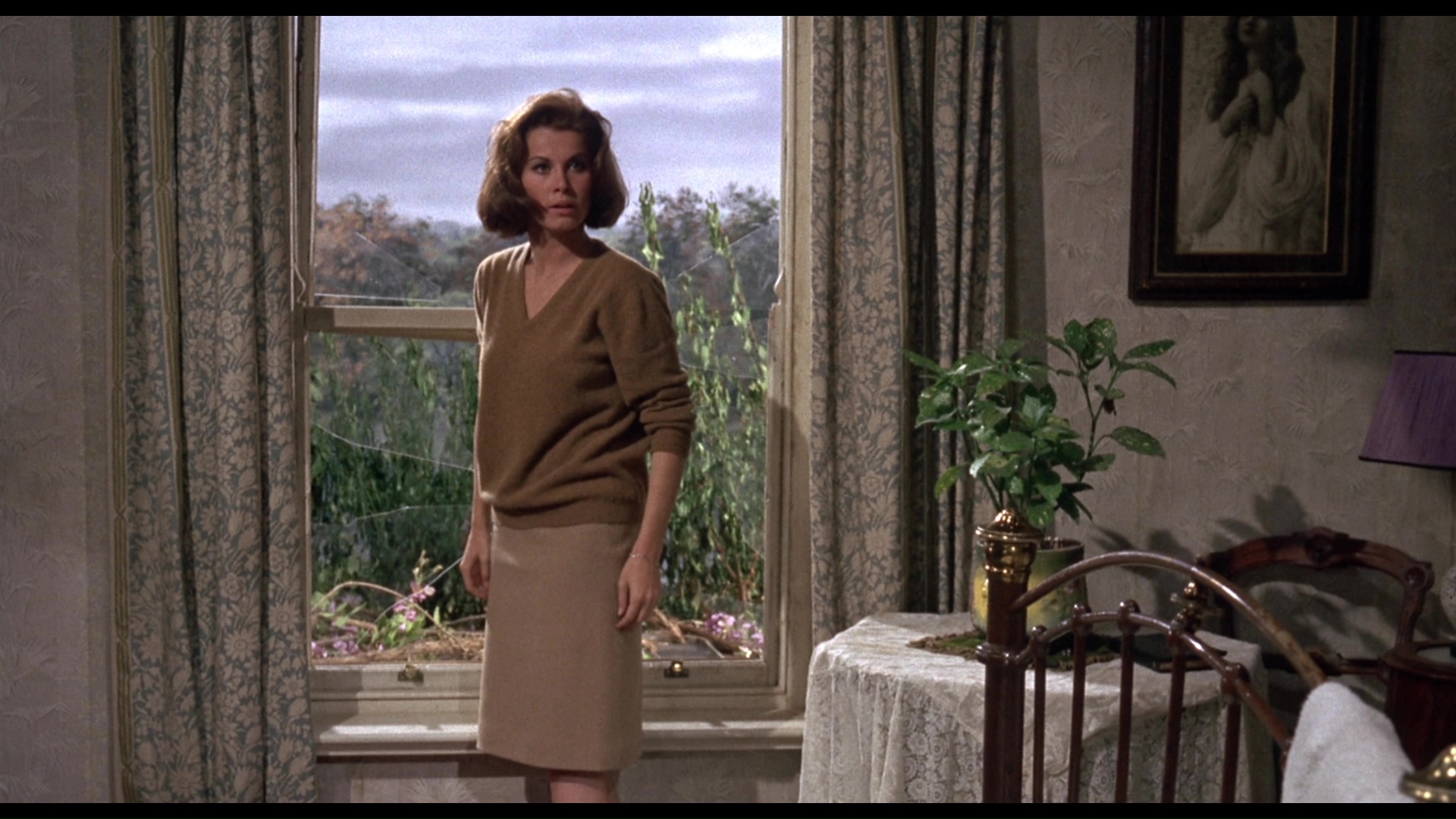 relies on earthier tones before shifting into wild, stylized designs later on as the story's psychosis angle really kicks in. Bankhead is always a sight to behold and holds her own against some of the other "elder stars" from the time like Bette Davis (who did The Nanny for Hammer the same year and, later, The Anniversary) and Joan Fontaine (in The Witches). Not to be overlooked is the presence of a young Donald Sutherland back in his early Euro horror days when he was popping up in films like Dr. Terror's House of Horrors and The Castle of the Living Dead. Tonally it's a really odd one with a whimsical undercurrent at the beginning and a threat to plunge into full-blooded horror by the midway point, though ultimately the story is ultimately more tragic than anything else. Definitely an odd but rewarding one that often gets overlooked.
relies on earthier tones before shifting into wild, stylized designs later on as the story's psychosis angle really kicks in. Bankhead is always a sight to behold and holds her own against some of the other "elder stars" from the time like Bette Davis (who did The Nanny for Hammer the same year and, later, The Anniversary) and Joan Fontaine (in The Witches). Not to be overlooked is the presence of a young Donald Sutherland back in his early Euro horror days when he was popping up in films like Dr. Terror's House of Horrors and The Castle of the Living Dead. Tonally it's a really odd one with a whimsical undercurrent at the beginning and a threat to plunge into full-blooded horror by the midway point, though ultimately the story is ultimately more tragic than anything else. Definitely an odd but rewarding one that often gets overlooked. 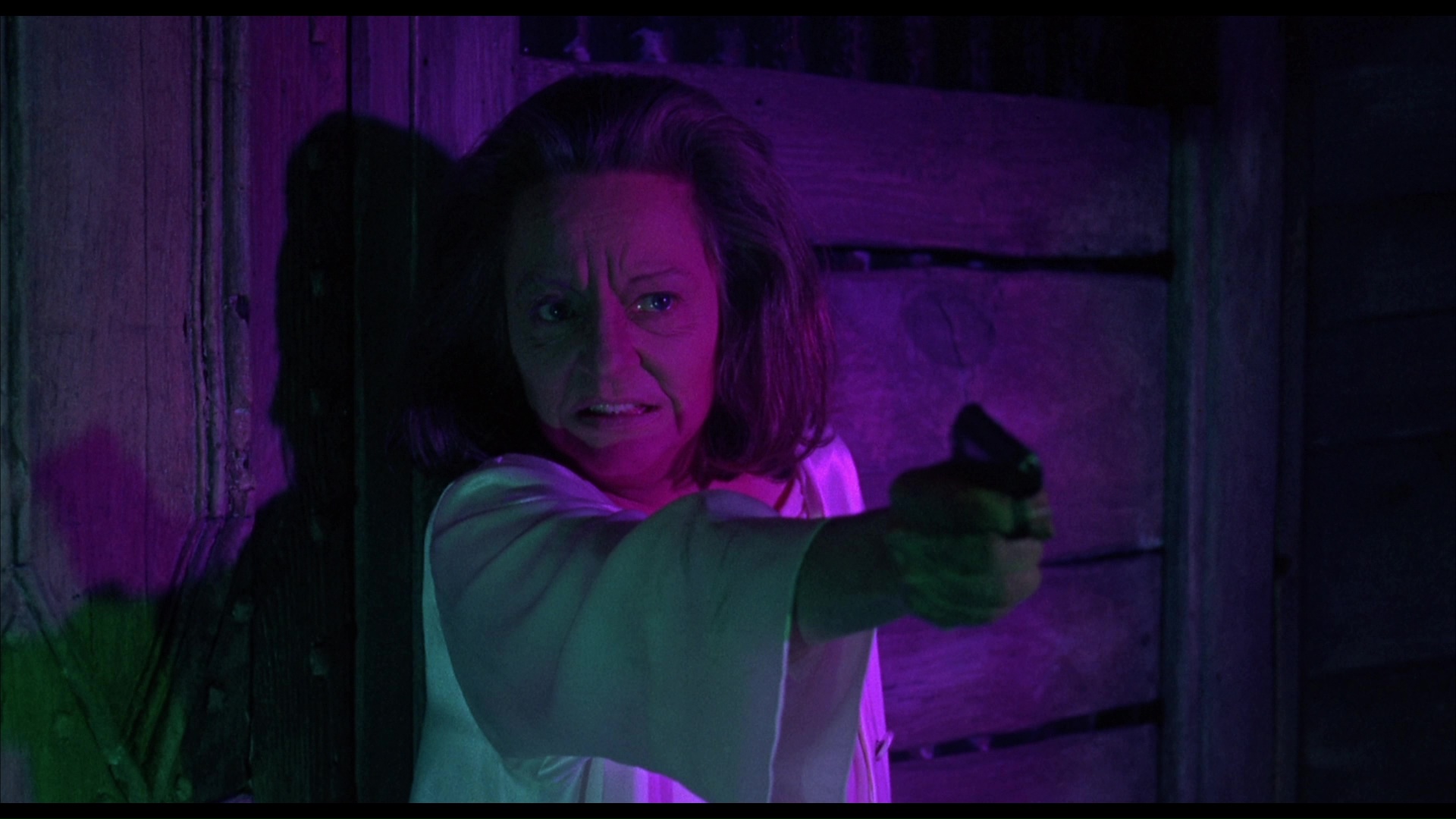 Fanatic first turned up on VHS from RCA/Columbia and then from Sony on DVD as Die! Die! My Darling, the latter featuring a really nice presentation for the time. The Indicator Blu-ray of Fanatic (which can also be played with its American Die! Die! main titles) looks rich and impressive throughout, and it's tough to imagine it looking much better. "House of Horror: Inside Fanatic" (14m27s) charts the film's path to the screen from an initial script by Richard Matheson through the eventual home at Columbia with a powerhouse name as its star, as well as the background on the title change. In "Hammer's Women: Tallulah Bankhead" (9m27s), Ellinger appears again for some background info on the glamorous icon including her famous
Fanatic first turned up on VHS from RCA/Columbia and then from Sony on DVD as Die! Die! My Darling, the latter featuring a really nice presentation for the time. The Indicator Blu-ray of Fanatic (which can also be played with its American Die! Die! main titles) looks rich and impressive throughout, and it's tough to imagine it looking much better. "House of Horror: Inside Fanatic" (14m27s) charts the film's path to the screen from an initial script by Richard Matheson through the eventual home at Columbia with a powerhouse name as its star, as well as the background on the title change. In "Hammer's Women: Tallulah Bankhead" (9m27s), Ellinger appears again for some background info on the glamorous icon including her famous 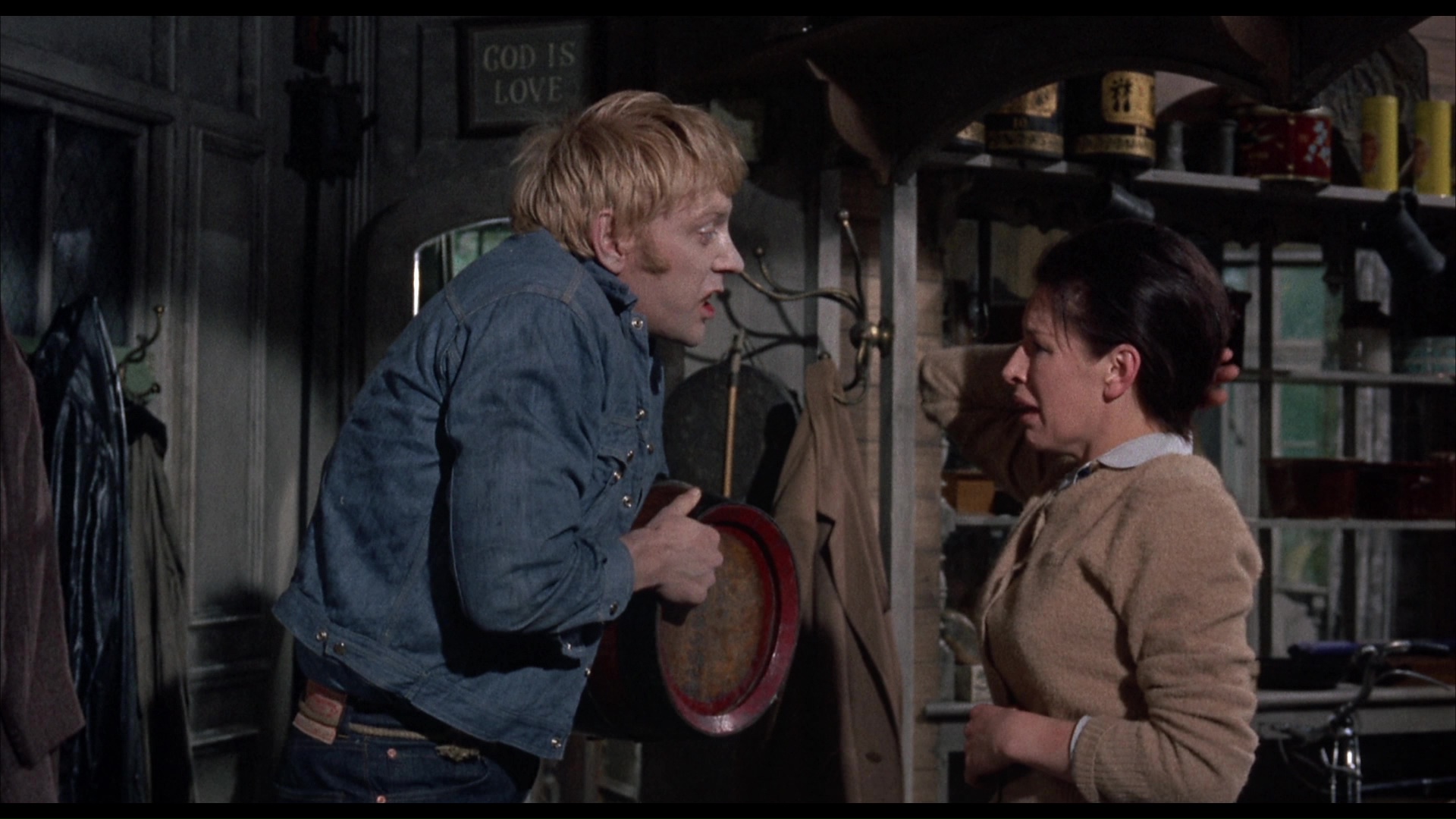 role in Lifeboat and her place in the lineage of female-driven horror films of the era including other Hammer offerings like The Witches. In "Fanatical Detail" (8m51s), bling-laden continuity supervisor Renée Glynne and second assistant director Stuart Black share some juicy stories about the set including a crazy kiss and make up story you have to hear. David Huckvale offers his take on the film's composer, Wilfred Josephs (13m48s), with an overview that goes from pop music 45s through his notable film scores, concert pieces, and experimental work, including a fun bit on the piano as he breaks down the complexity of this film's whimsical, unexpected main theme. Finally on the featurette side, playwright Matthew Lombardo relates his own Bankhead experience (6m59s) including a tape of Bankhead repeatedly trying to loop a line in this film, which ended up inspiring his play Looped. Also included are the incredibly lurid American trailer and a huge gallery of promotional material.
role in Lifeboat and her place in the lineage of female-driven horror films of the era including other Hammer offerings like The Witches. In "Fanatical Detail" (8m51s), bling-laden continuity supervisor Renée Glynne and second assistant director Stuart Black share some juicy stories about the set including a crazy kiss and make up story you have to hear. David Huckvale offers his take on the film's composer, Wilfred Josephs (13m48s), with an overview that goes from pop music 45s through his notable film scores, concert pieces, and experimental work, including a fun bit on the piano as he breaks down the complexity of this film's whimsical, unexpected main theme. Finally on the featurette side, playwright Matthew Lombardo relates his own Bankhead experience (6m59s) including a tape of Bankhead repeatedly trying to loop a line in this film, which ended up inspiring his play Looped. Also included are the incredibly lurid American trailer and a huge gallery of promotional material. 